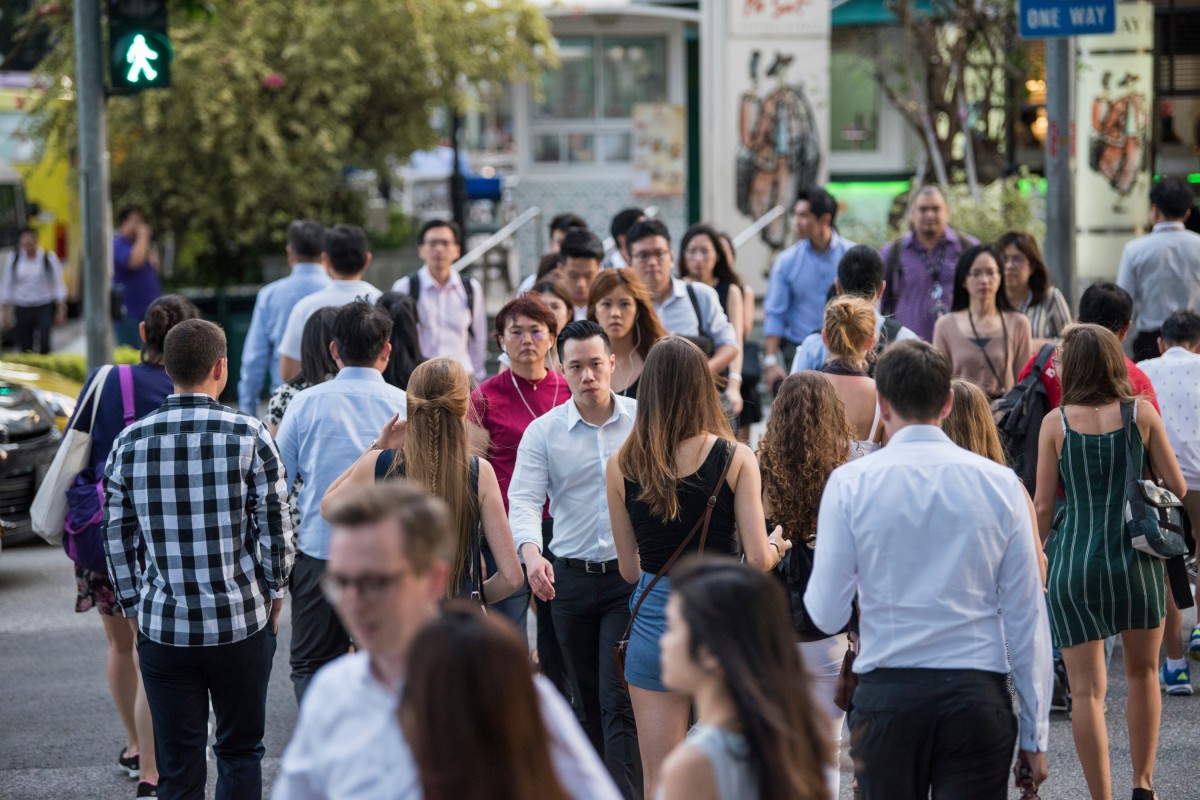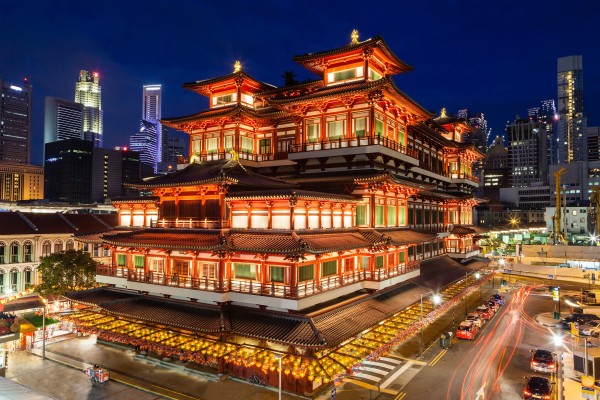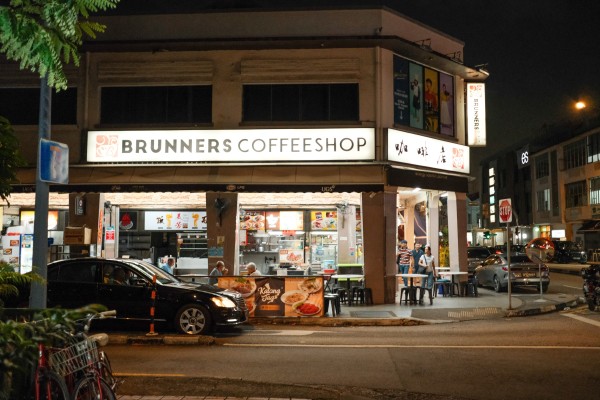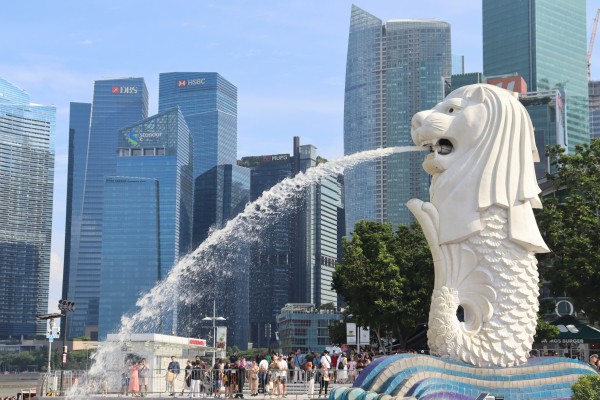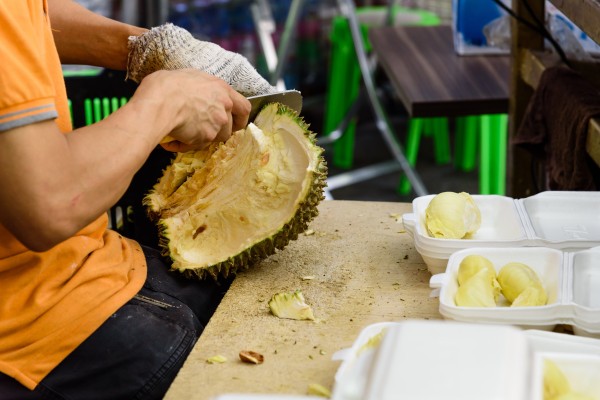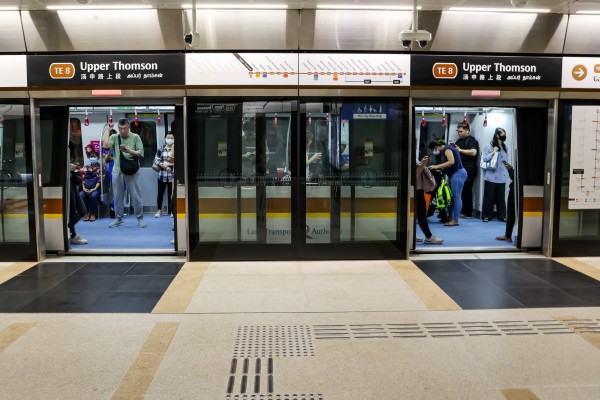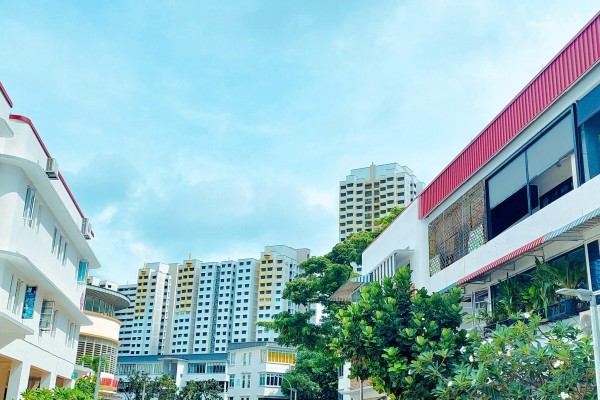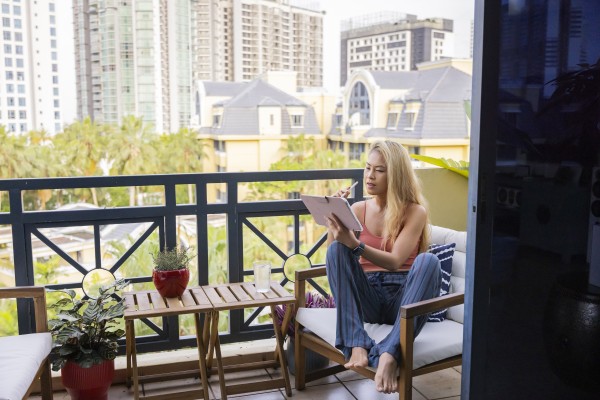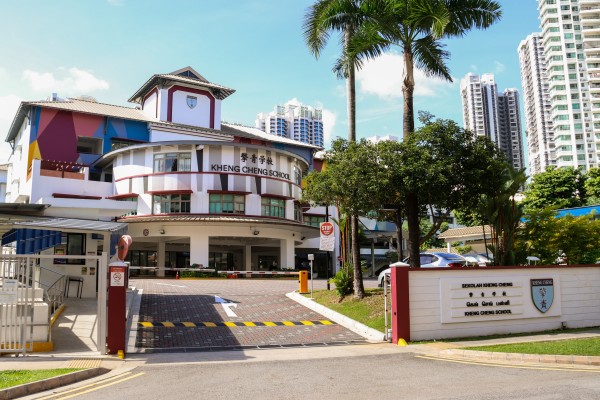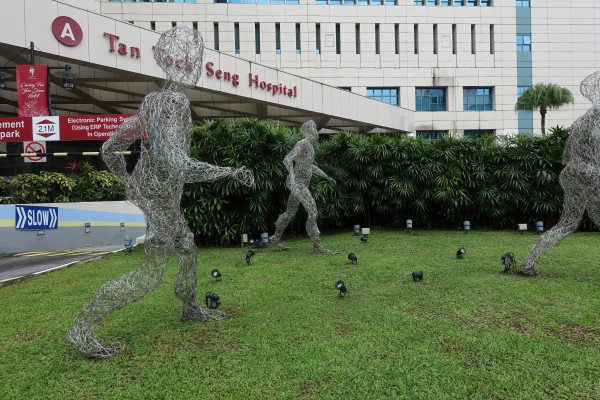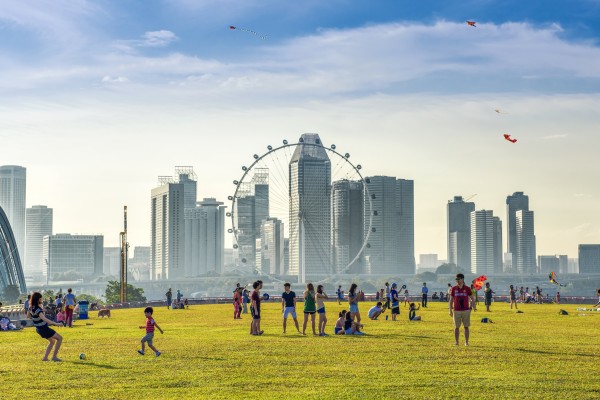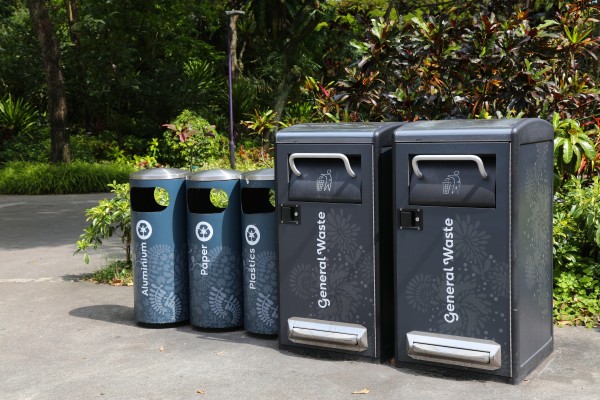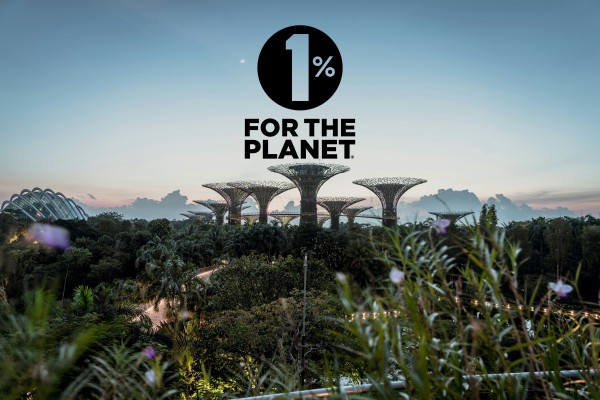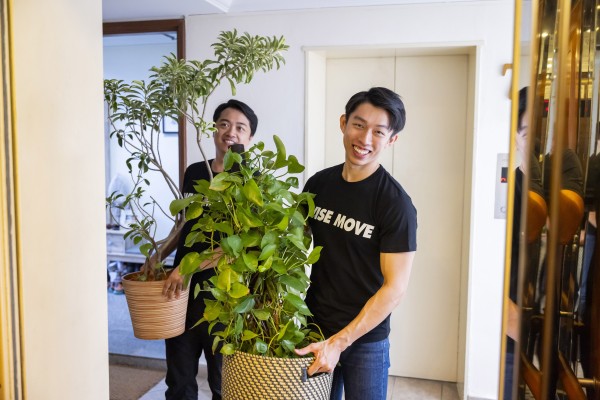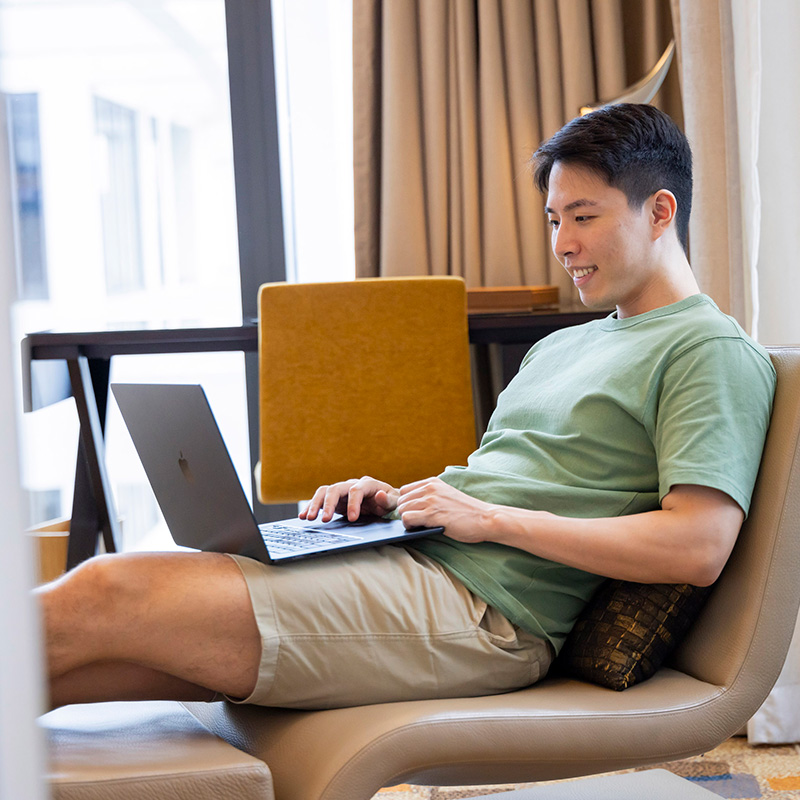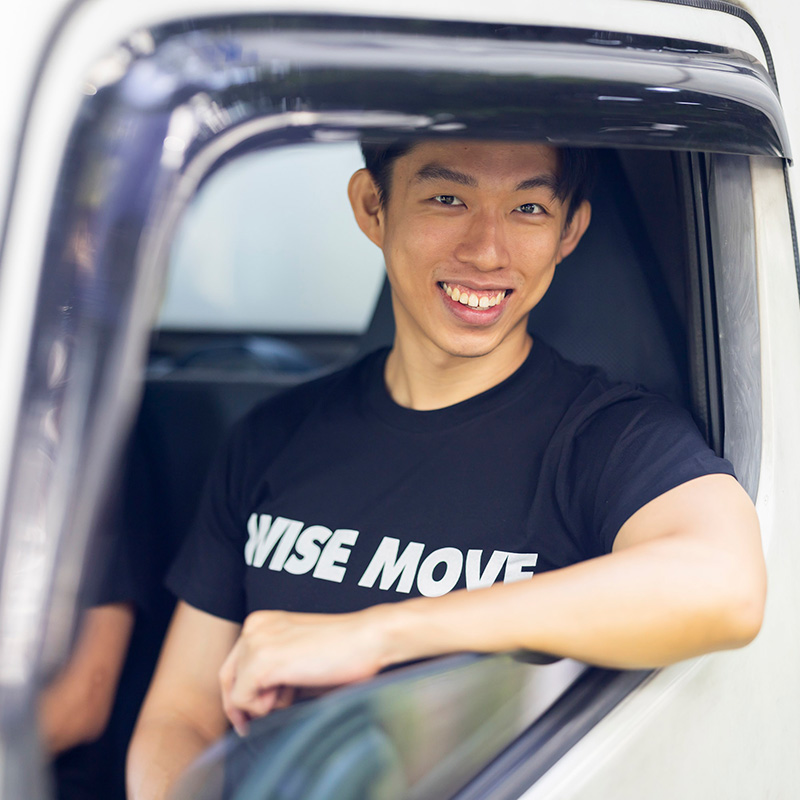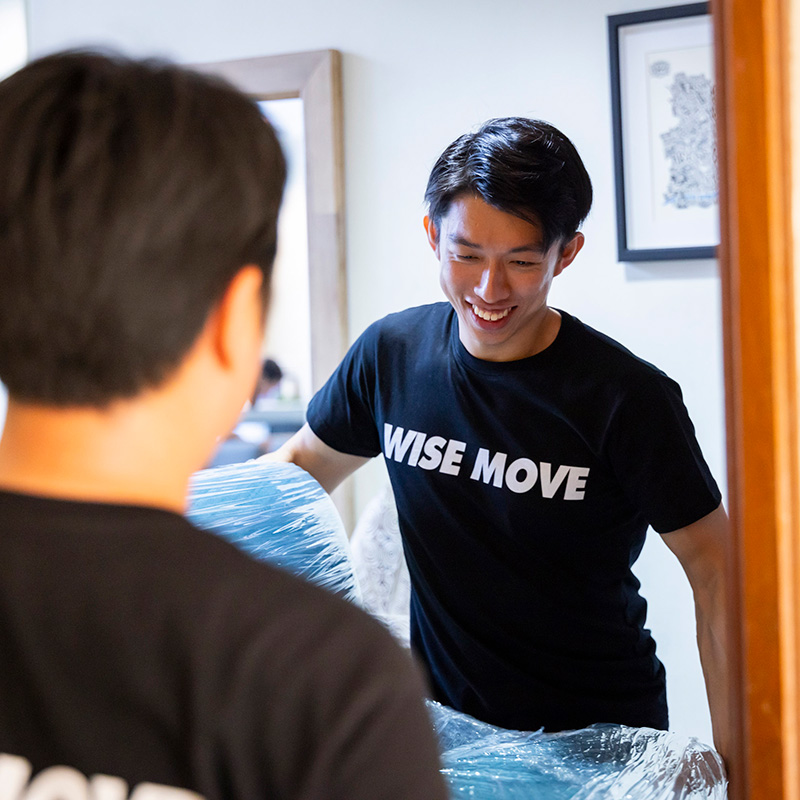A neighbourhood guide to Chinatown in Singapore

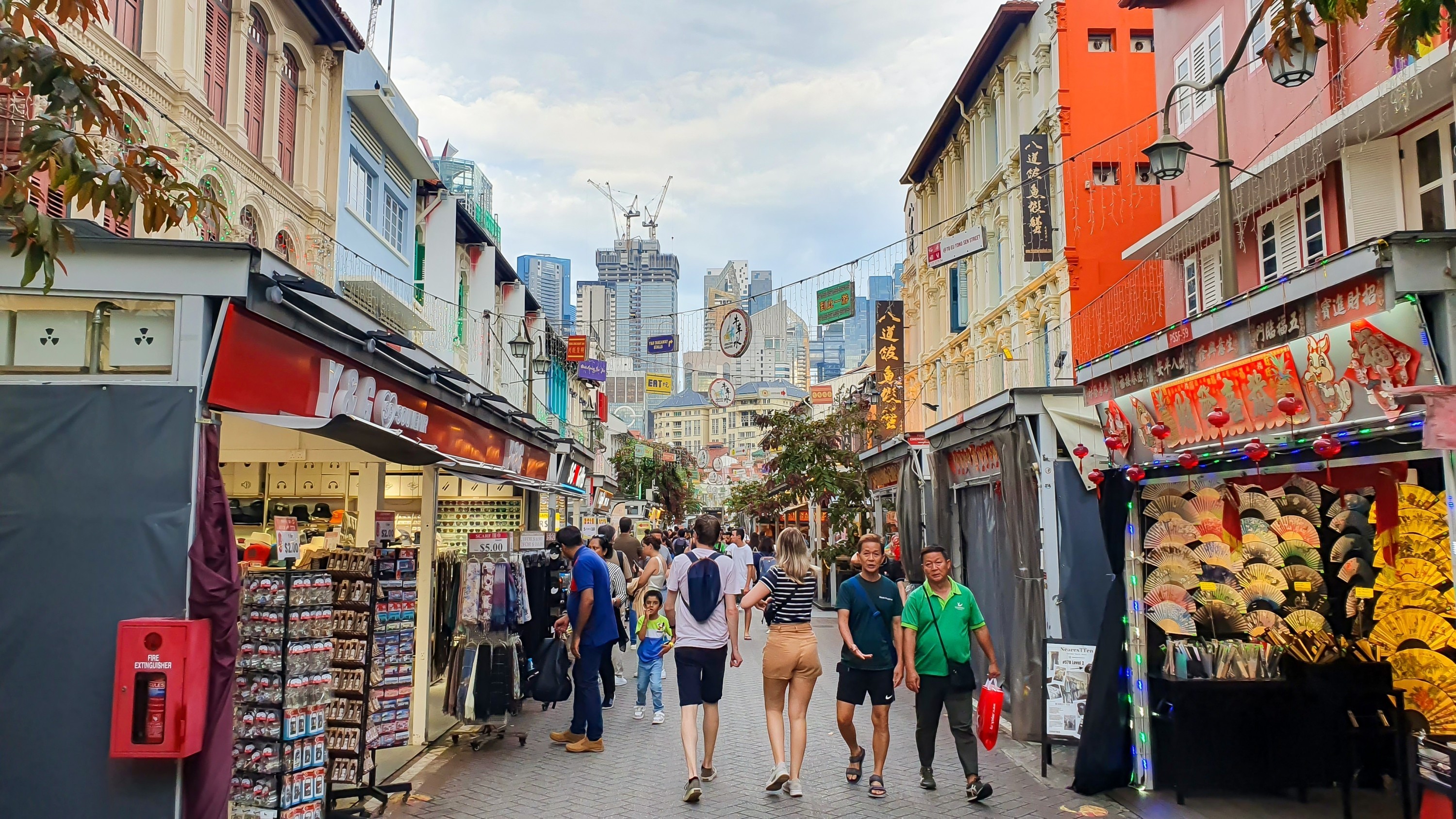
More than 35 countries in the world have Chinatowns—bustling, buzzing hives of activities with Chinese shops and restaurants, clan associations, and temples. These neighbourhoods were traditionally where the immigrant Chinese community first entered their new countries, serving as a landing point to transit into new cultures.
Chinatowns were first established in the mid-19th century—when the Treaty of Peking was signed in 1860 between China, Great Britain, France, and Russia to allow the emigration of Chinese people to these countries.
In some cities, these neighbourhoods were established as designated areas for ethnic Chinese immigrants to stay in, such as in San Francisco. In other cities, Chinatowns organically formed where the Chinese community tended to congregate for work, such as the Chinese prospectors who flocked to Little Bourke Street in Melbourne during the Gold Rush.
Today, Chinatowns remain important cultural bastions for the Chinese diaspora—and it is no different in Singapore.
What makes Singapore’s Chinatown so unique?
In a country like Singapore with 75% of its population being ethnically Chinese, is there even a point in having a Chinatown?
You’ll have to pay a visit to this neighbourhood and decide for yourself.
A heady blend of modernity and tradition, Singapore’s Chinatown is a feast for the senses. The landscape is a mix of restored shophouses from the past century, bustling street markets, old-school hawker centres and shopping buildings, as well as a swanky new mall.
And in the true spirit of Singapore’s famous multiculturalism, Chinatown is even home to Hindu temples and Muslim mosques.
Read on to find out more about the history of Singapore’s Chinatown and what you should definitely do while you’re there.
History of Chinatown in Singapore
First established in the early 19th century, Singapore’s Chinatown was developed along the west of the Singapore River, on land allocated by Sir Stamford Raffles.
The town was known as the Chinese Campong (from the Malay word "kampong", which means community settlement).
At that time, there was an influx of Chinese immigrants from China, particularly from the southern provinces of Guangtong and Fujian. These immigrants worked primarily as coolies (unskilled manual labourers), businessmen, traders, hawkers, craftsmen, and peddlers.
The initial township was divided into separate zones for each dialect group. For example, the Cantonese were at Temple Street; the Teochews were at South Canal Road, Carpenter Street, and Garden Street; and the Hokkiens were at Telok Ayer Street and Hokkien Street. Each area also housed specific trades.
Temples, clan associations (known as huay guans), guilds and trade unions were also prominent features in Chinatown, with each dialect group having its own temple and clan association where they could go for help and advice.
Interestingly, the architecture of Chinatown during this time was characterised by elegant shophouses built in baroque and Victorian architectural style, and larger Italian-style terraces with strong Mediterranean influences.
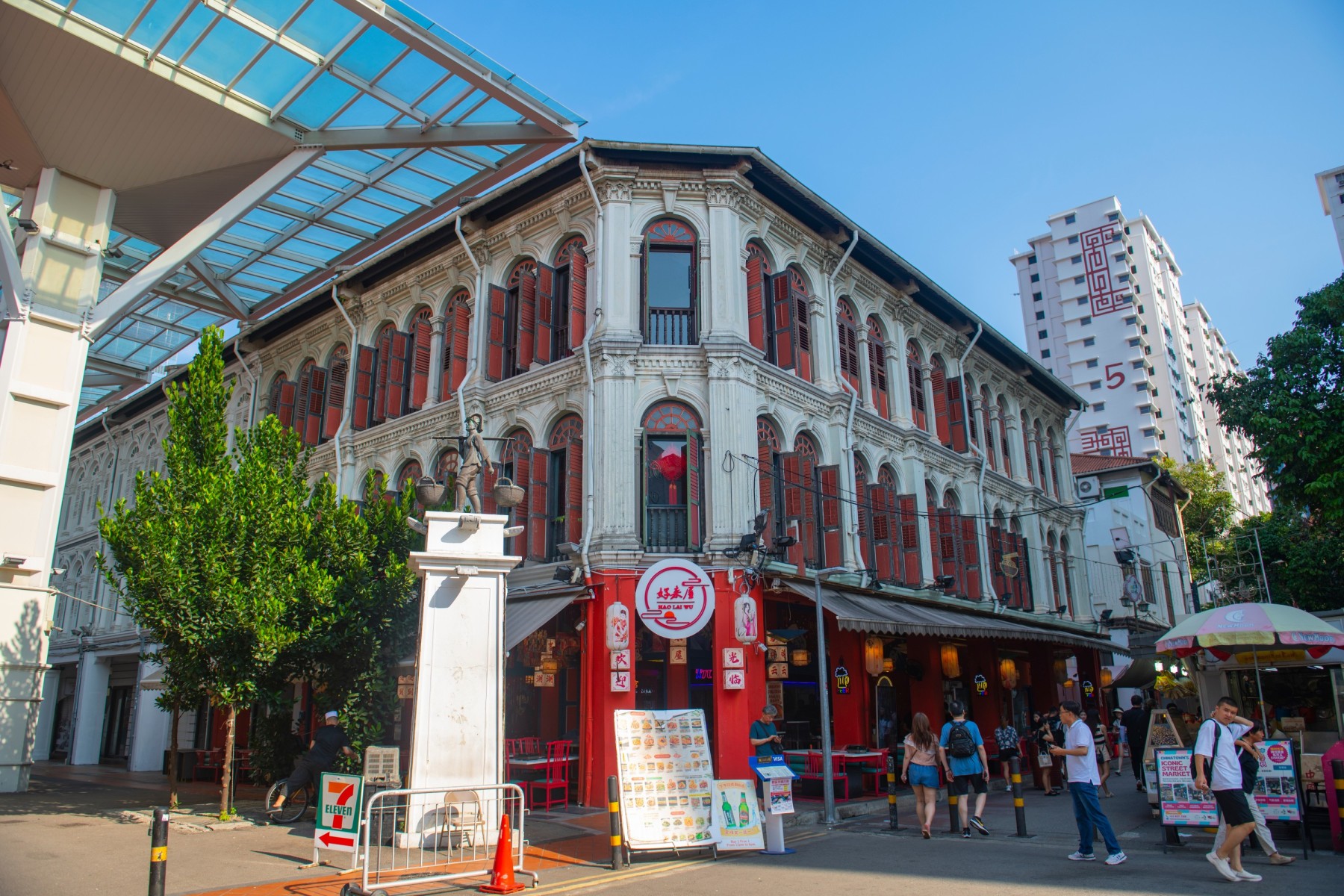
The reason for this is that many of the immigrants had some knowledge of the Portuguese architecture of Goa, Macau, and Malacca – places they may have stopped by en route to Singapore.
Five-foot ways—covered walkways with a depth of five feet—were also mandatory features of shophouses at this time. Sir Stamford Raffles had made it so, to ensure that pedestrians would always be sheltered from the rain or the sun.
However, the development of the enclave couldn’t keep up with the population explosion, as more and more Chinese immigrants made Singapore their home. Chinatown quickly became overcrowded, with many people squeezing into sub-divided rooms, often as small as cubicles. This was unsanitary and unsafe.
With urban renewal in the 1950s, people eventually were forced to move into government-built Housing and Development Board (HDB) flats, shophouses were renewed and restored, and new buildings to house all the street hawkers were built.
Even back then, Chinatown was not exclusively inhabited by the Chinese, although they did definitely make up the vast majority of residents in the township. Hindu Indians and Malays lived there too, as evidenced by the establishment of Hindu temples and mosques.
Overview of Chinatown in Singapore
Also known today as Niu Che Shui (牛车水), which means “Water Buffalo Cart” in Chinese, Singapore’s Chinatown is culturally vibrant and bustling with activity today.
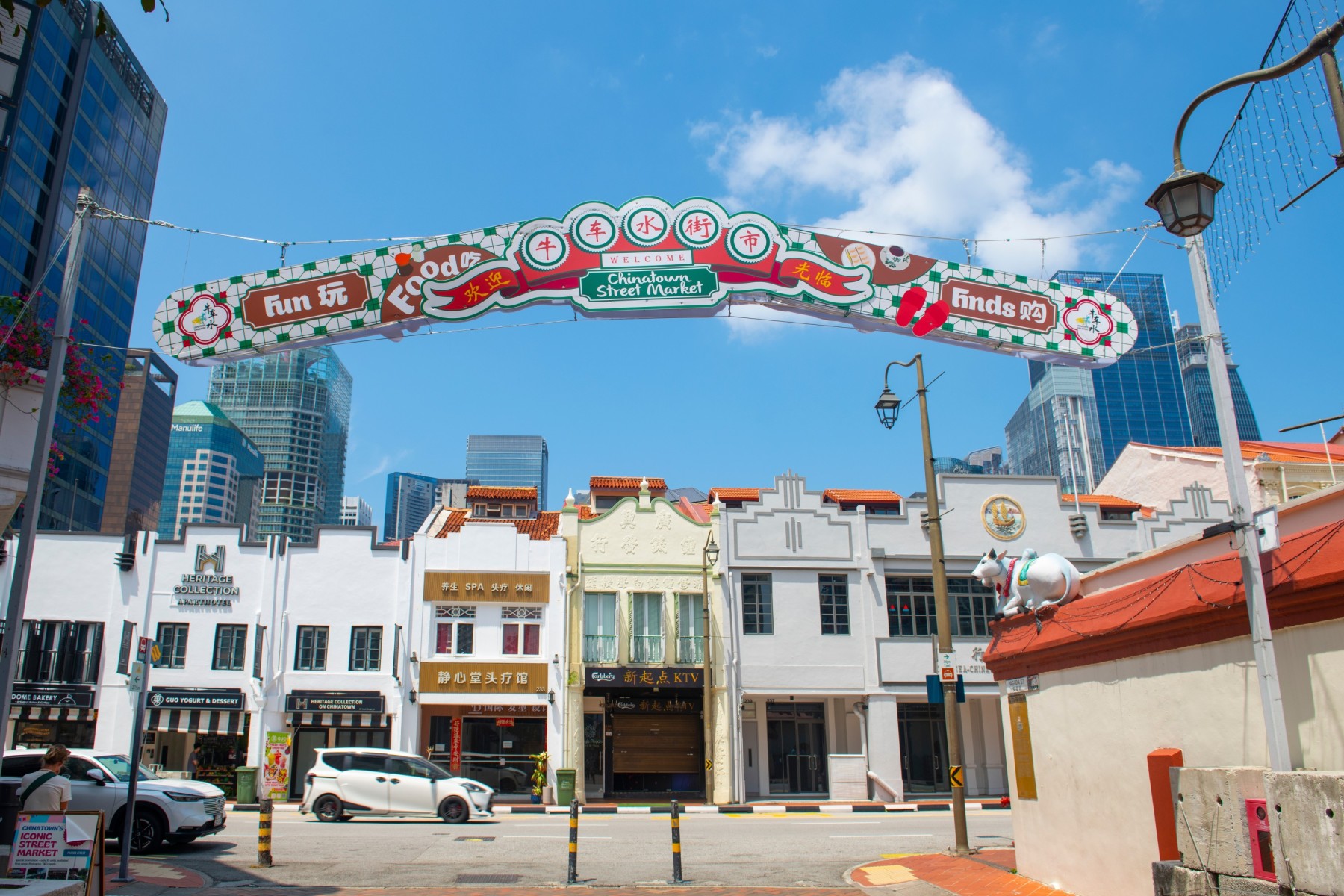
In the past, the town was constantly expanding, starting from Pagoda Street, Temple Street, Smith Street, Trengganu Street, Sago Street and Sago Lane; and eventually growing to include Telok Ayer Street, Singapore River, New Bridge Road, Pagoda Street, Upper Pickering Street, Upper Hokkien Street, Upper Chin Chew Street, Upper Cross Street and Mosque Street too.
Today, Chinatown is largely bounded by North Bridge Road, South Bridge Road, New Bridge Road, Eu Tong Sen Street, Neil Road, and Cantonment Road.
There are five main districts within the neighbourhood. Each has its own distinct flavour and unique things to do. What is the one thing that can be found in all the districts? Amazing food.
Kreta Ayer
Today, the Kreta Ayer district generally refers to the area bound between Neil Road, New Bridge Road and Eu Tong Sen Street, with Keong Saik Road running through.
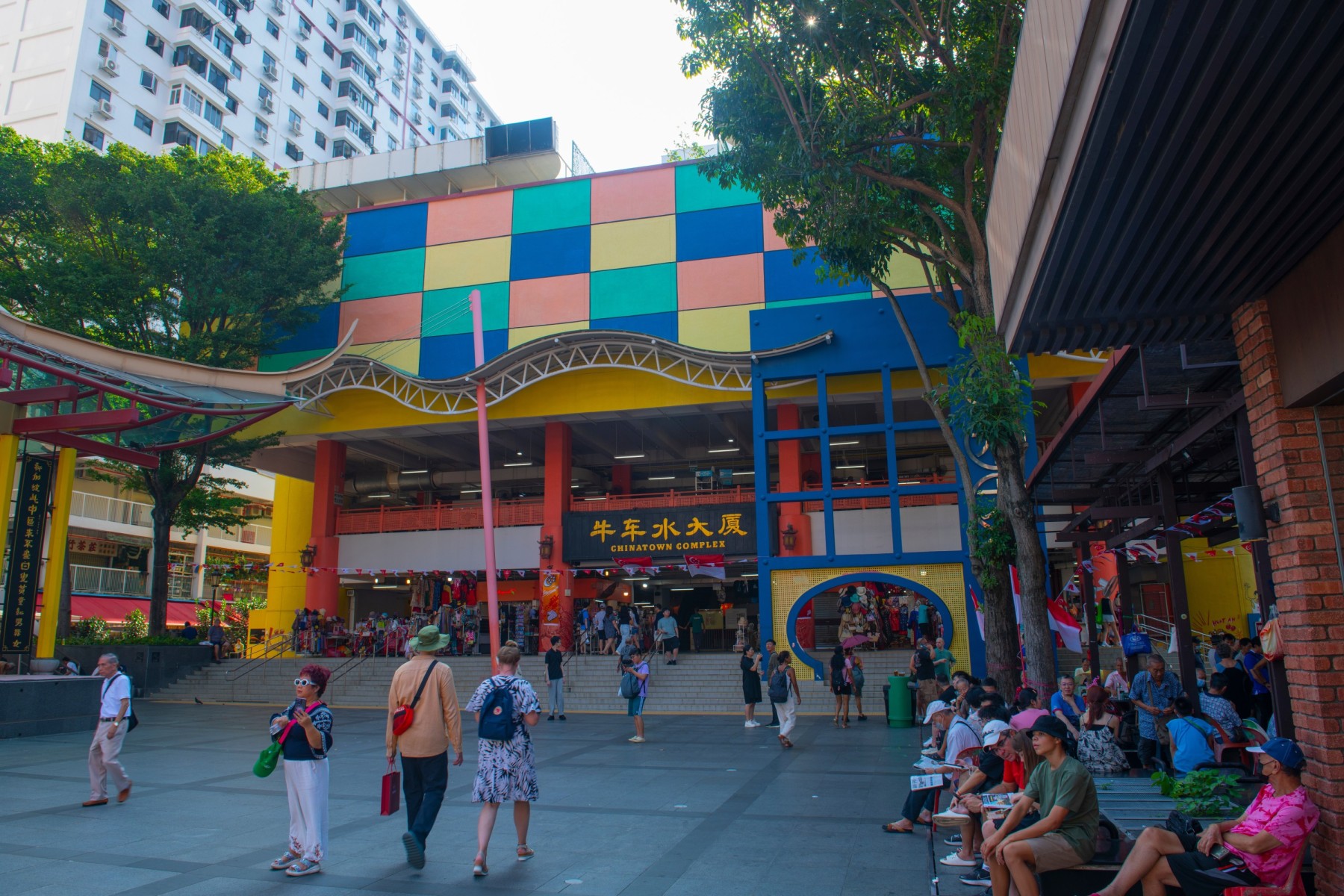 As part of the Chinatown Kreta Ayer Conservation Area, it holds many of Chinatown’s key community sites, including the Kreta Ayer Community Centre, Chinatown Complex, The People’s Theatre, and conserved shophouses.
As part of the Chinatown Kreta Ayer Conservation Area, it holds many of Chinatown’s key community sites, including the Kreta Ayer Community Centre, Chinatown Complex, The People’s Theatre, and conserved shophouses.
The streets in this precinct are also lined with HDB residential, lots of eateries, and craftsmen engaged in trades from yesteryear—like chopstick making.
The Chinatown Heritage Centre is also located here, a rich repository of the neighbourhood’s history for visitors to learn about and explore in both an interactive and educational manner.
One of the biggest and most eye-catching temples in Singapore is the Buddhist Tooth Relic Temple—a majestic complex built in the style of the Tang dynasty, with some Japanese and Tibetan Buddhist influences. There is also a museum in the complex, with exhibits detailing the lives of prominent monks, as well as works showcasing Buddhist culture.
Kreta Ayer, which means water cart in Malay, was named for the bullock carts that once plied the streets of Chinatown as the main mode of transportation in 18th and 19th-century Singapore.
Ann Siang / Club Street
This atmospheric Ann Siang Hill area, with its rows of restored colourful shophouses, is home to some of the best bars and restaurants in Singapore, offering culinary excellence and cutting-edge concepts wherever you look.
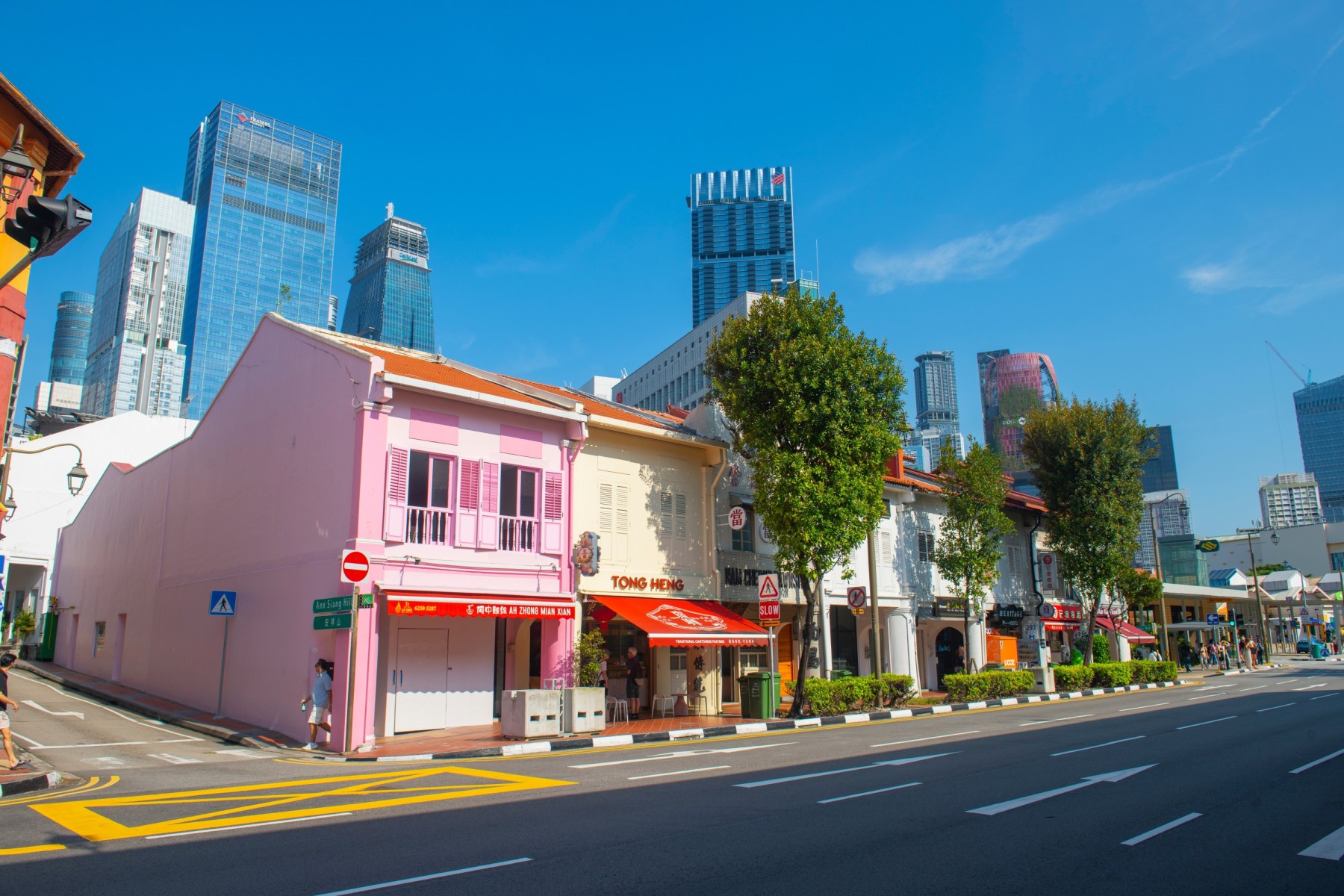 These trendy night spots are charmingly nestled amid old-world clan associations and tea houses—as well as modern fitness studios, art galleries, and boutique hotels—visiting this enclave unforgettable in its depth of diversity.
These trendy night spots are charmingly nestled amid old-world clan associations and tea houses—as well as modern fitness studios, art galleries, and boutique hotels—visiting this enclave unforgettable in its depth of diversity.
Ann Siang Street and Ann Siang Hill are named after wealthy Hokkien merchant and philanthropist, Chia Ann Siang —one of Singapore’s richest landowners and merchants in the 19th century. He made his fortune trading natural resources from the region, such as spices, coconut, tobacco, tin, tea and silk for the British trading firm, Boustead and Company.
Club Street was named for the row of Chinese clubs that once lined the street. These clubs were frequented by Chinese businessmen entertaining guests and clients.
Telok Ayer
As the original landing site for Chinese immigrants in the 19th century, Telok Ayer is where you can find many religious sites and clan association buildings—iimportant aspects of life back then to newly arrived immigrants.
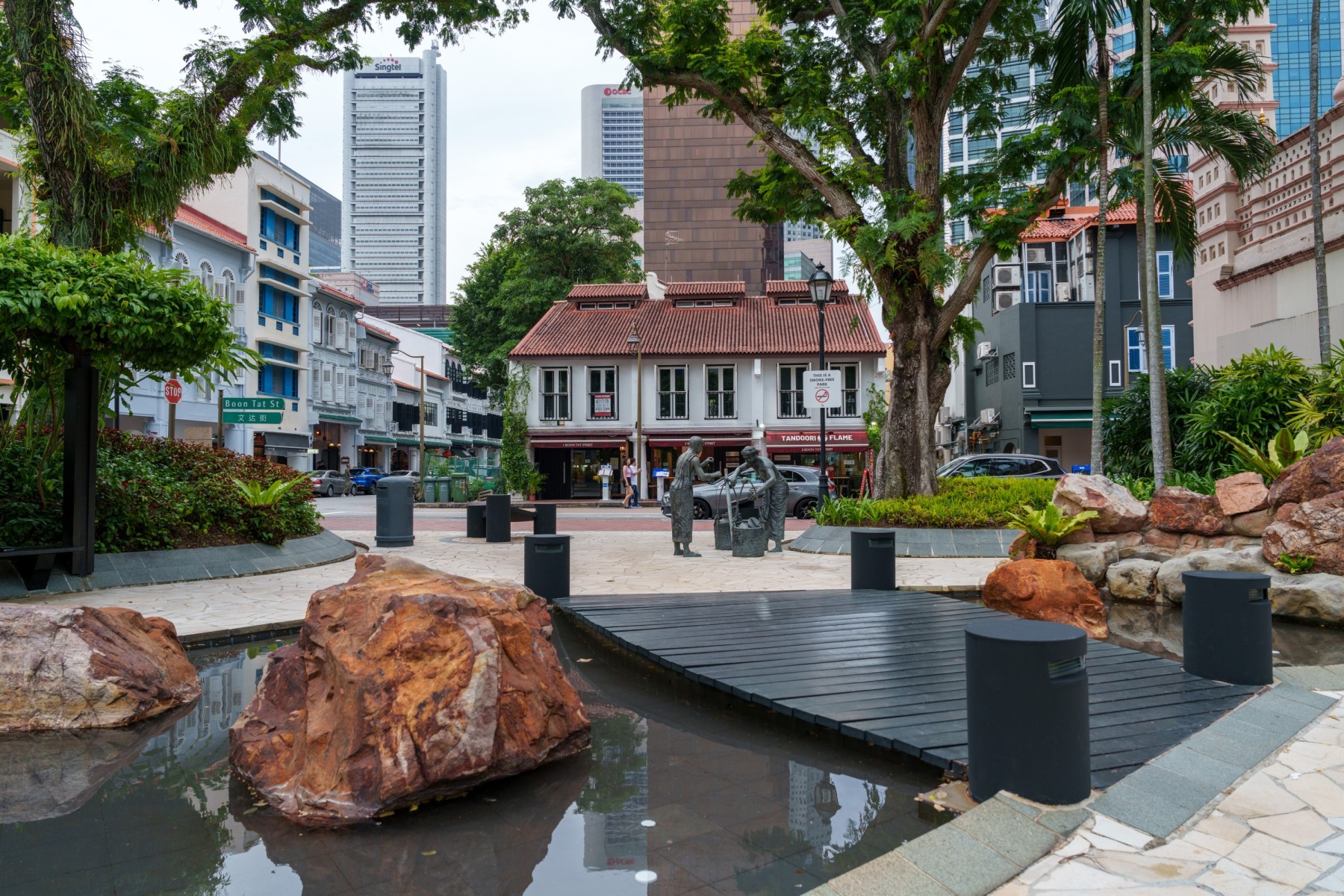 Some prominent places of worship in Telok Ayer include Thian Hock Keng Temple, Fuk Tak Chi Temple, Ying Fo Fui Kun Hakka Association Hall, Hock Teck See Temple, Nagore Durgha Shrine, Al-Abrar Mosque and the Chinese Methodist Church.
Some prominent places of worship in Telok Ayer include Thian Hock Keng Temple, Fuk Tak Chi Temple, Ying Fo Fui Kun Hakka Association Hall, Hock Teck See Temple, Nagore Durgha Shrine, Al-Abrar Mosque and the Chinese Methodist Church.
Bounded by Telok Ayer Street, Anson Road, and Market Street—with the skyscrapers of the Central Business District (CBD) and trendy cafes just a stone’s throw away amidst historical and cultural buildings—Telok Ayer today exemplifies much of what it means to live in a country like Singapore, at the crossroads of modernity and tradition.
The Amoy Street Food Centre is popular among the older folk and office workers around the vicinity, for its affordable and delicious fare.
Telok Ayer is the Malay word for “bay water,” and was named for being the coastal road along the Singapore River.
Tanjong Pagar
An area equally steeped in heritage as it is at the forefront of Singapore’s economic development. Its modern skyscrapers and offices housed in charming shophouses, Tanjong Pagar is unique in its own right.
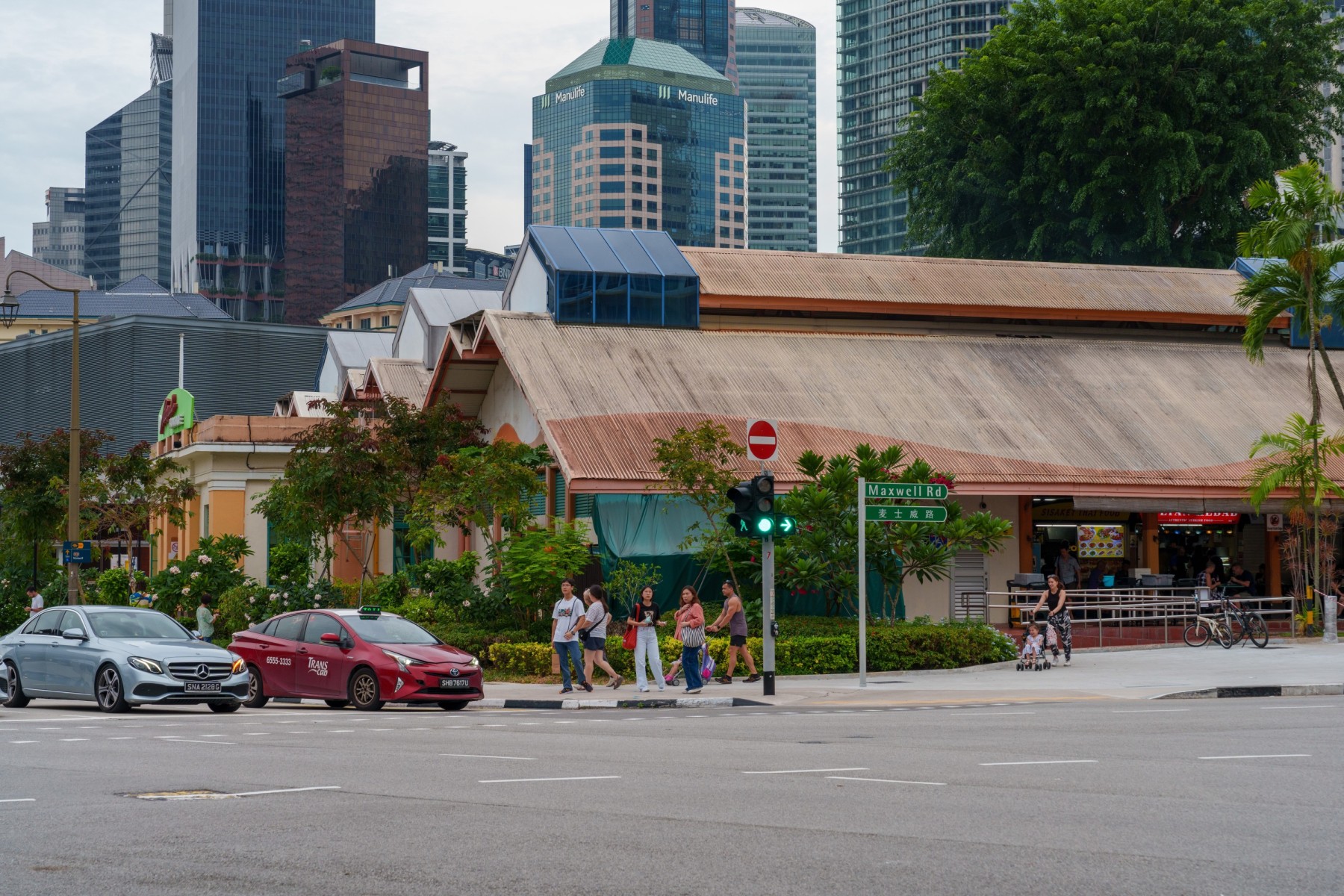 Bounded by Neil Road, Maxwell Road, Peck Seah Street, Wallich Street, Tanjong Pagar Road and Craig Road— this precinct sits amid Singapore’s bustling CBD, is also home to a wide array of eateries from all over the world, and offers lots of residential options.
Bounded by Neil Road, Maxwell Road, Peck Seah Street, Wallich Street, Tanjong Pagar Road and Craig Road— this precinct sits amid Singapore’s bustling CBD, is also home to a wide array of eateries from all over the world, and offers lots of residential options.
Here, you’ll also find Maxwell Hawker Centre, a popular spot for local office workers and tourists alike to find their favourite Singapore dishes—some of which are lauded to be the best in the country.
Pinnacle@Duxton, Singapore’s tallest and most distinctive HDB project, is located within Tanjong Pagar too. The apartment block is an architectural wonder, comprising seven connected 50-storey blocks and the world’s longest sky gardens to be built on a skyscraper.
Visitors who want to take in the view from the sky garden on the 52nd floor even have to pay an entrance fee of SG$6.
Its name, Tanjong Pagar, is the Malay word for “cape of stakes”—reflecting the district’s past as a sleeping village built on a former rocky headland at the Singapore River, long before any land reclamation works were carried out.
Bukit Pasoh
This hilly stretch of Chinatown is well worth a visit. Firstly, for its atmospheric art deco and transitional-styled shophouses. Secondly, for the trendy experiential eateries and stores within them. It was granted conservation area status in 1989.
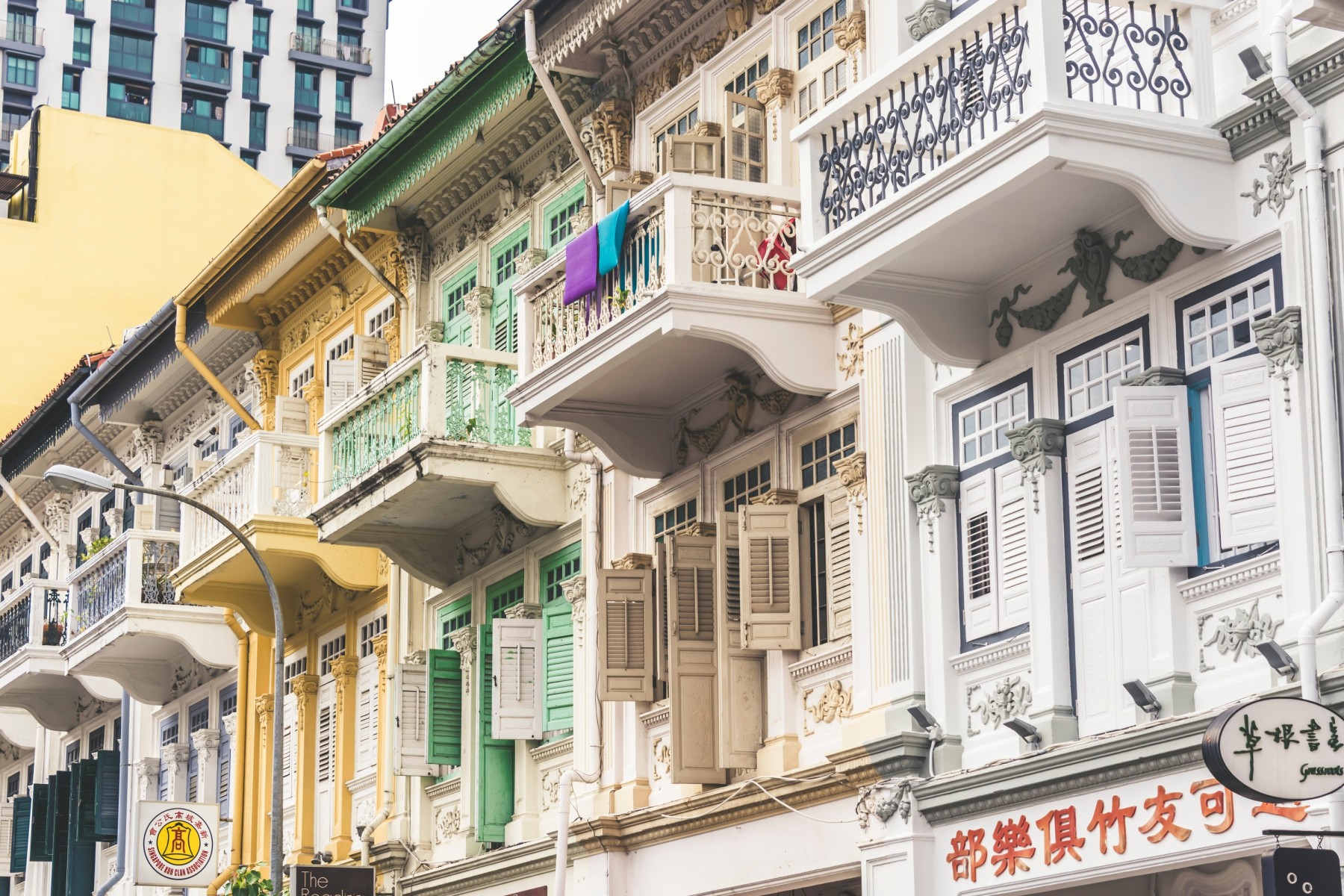 Today, the Bukit Pasoh district is bounded by New Bridge Road, Keong Saik Road, Kreta Ayer Road, Neil Road and Cantonment Road.
Today, the Bukit Pasoh district is bounded by New Bridge Road, Keong Saik Road, Kreta Ayer Road, Neil Road and Cantonment Road.
The name Bukit Pasoh is the Malay word for “hill of flower pots”—for its hilly terrain and many earthenware pottery kilns that were once located in the area. These Ali Baba-style pots were mainstays in many homes back then and were used to store water and rice.
What can I do in Singapore’s Chinatown?
Bookmark this guide for an evergreen list of things you can do in Singapore’s Chinatown. Whether you enjoy culture, shopping for quirky and traditional goods, chill afternoons at a cafe, electrifying nightlife, hunting down local nosh, or fine dining, there’s something for you!
Eat
There’s so much more to the food in Singapore’s Chinatown than just Chinese food. The Chinatown area is well-known to be a complete foodie’s paradise that even locals frequent (so you know, it’s not just a tourist trap).
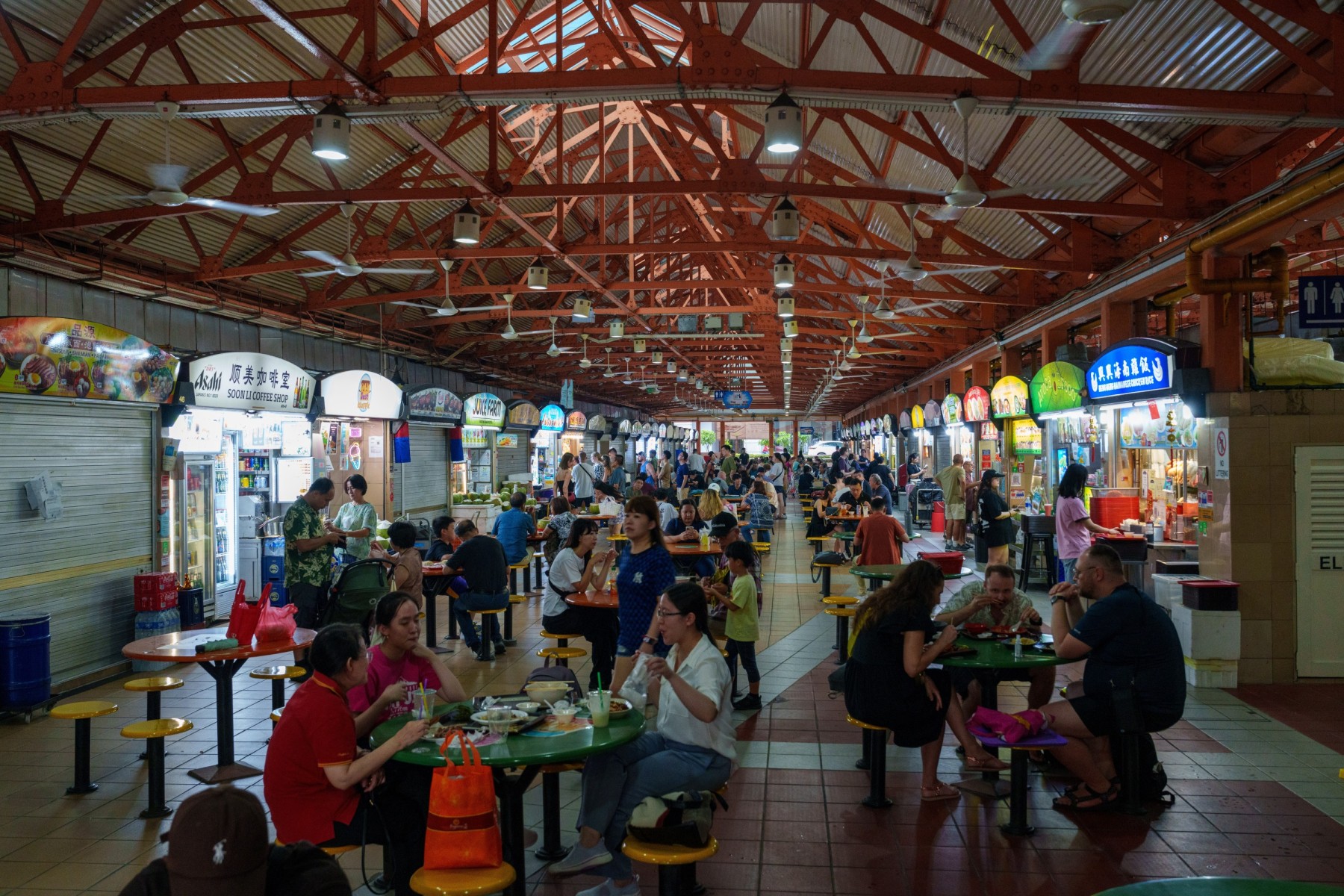
Hawker Centres
Hawker centres offering a mouthwatering variety of affordable and authentic local fare are aplenty in the neighbourhood, with at least one in every Chinatown district. The name is fitting, considering how the many hawkers who used to sell their delicious wares along the streets of Chinatown in the past were moved to government-built hawker centres in the 1970s and 1980s.
If you’ve got a craving for a hot bowl of wonton noodles, a savoury plate of tender chicken rice, freshly fried char kway teow (flat rice noodles fried with dark sauce, lard, and beansprouts with an assortment of seafood or sausages), or a cup of aromatic kopi (that’s traditional sock-pulled coffee)—you’ll find that in any one of these hawker centres in Chinatown:
-
Maxwell Food Centre
-
People’s Park Food Centre
-
Chinatown Food Centre
-
Amoy Street Food Centre
-
Tanjong Pagar Food Centre
-
Hong Lim Food Centre
-
Market Street Hawker Centre
-
Lau Par Sat
Dim Sum
When in Chinatown, the craving for dim sum (a traditional Chinese meal comprising bamboo baskets of food you can pop into your mouth in one bite) surely hits differently.
After all, it’s one of the mainstays of Chinatowns all over the world, with people heading to Chinatown specifically to enjoy a dim sum meal.
Check out Yum Cha Restaurant, Fortune Garden Restaurant, Mansion 7 Cantonese Cuisine Restaurant, Peach Garden Restaurant, and Hong Kong Mong Kok Tim Sum for some delectable dim sum when you’re in Chinatown in Singapore.
For the full dim sum cart experience, where you can take the bamboo baskets right off trolley carts pushed around in the restaurant by ladies who will stop by your table to tell you what’s available, you’ll want to check out Yum Cha Restaurant at lunchtime!
Drink
Chinatown’s bar scene is a total vibe—comprising of the super chic set, raving party bars, immersive experiential spots, well-kept secret bars, and unassuming bars operating out of old-school shophouses or hawker centres selling the best craft beers on tap. Some of our best recommendations for 2025 are:
1939 Singapore (formerly Potato Head)
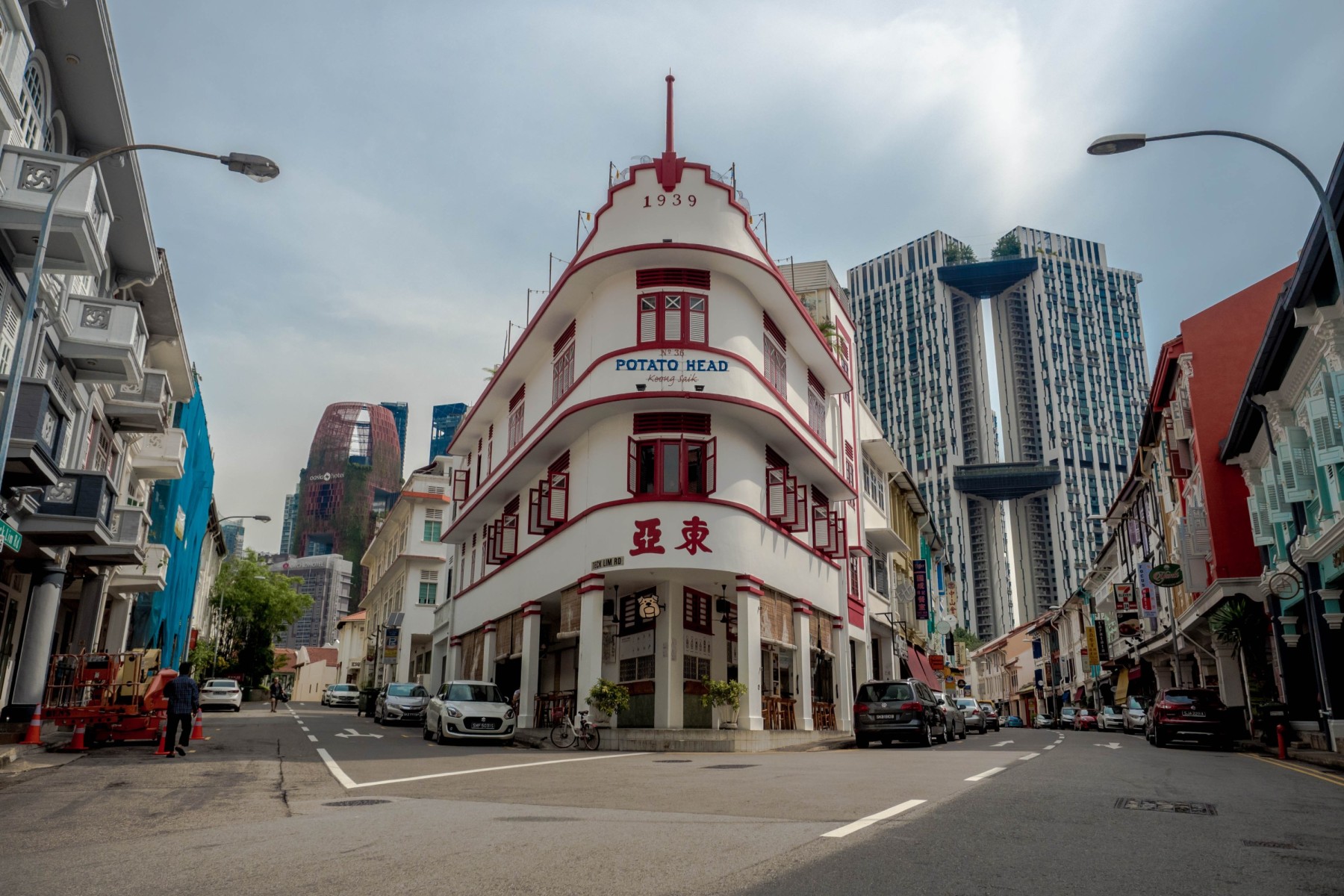 This multi-concept establishment with three different eateries, each offering something different, is housed in a graceful red-and-white corner shophouse along Keong Saik. It was formerly known as Potato Head—a popular hangout spot for those aching for those beachy-Bali vibes.
This multi-concept establishment with three different eateries, each offering something different, is housed in a graceful red-and-white corner shophouse along Keong Saik. It was formerly known as Potato Head—a popular hangout spot for those aching for those beachy-Bali vibes.
- Address: 36 Keong Saik Road, Chinatown, Singapore 089143
Smith Street Taps
It truly doesn’t get more authentically Singaporean than this— fresh craft beer on tap at a pop-up store in a quintessential hawker centre, Chinatown Complex. Best paired with the neighbouring stalls’ dishes.
- Address: Blk 335 Smith Street Chinatown Complex #02-062, Singapore 050335
Sago House
Here, there are always six cocktails on the men—but you never know what’s on for the week, depending entirely on what’s available at the local markets. Take the time to appreciate the bar’s interior which was created entirely by hand—80% of which was made using upcycled materials.
- Address: 37 Duxton Hill Singapore 089615
The Wizard’s Brew
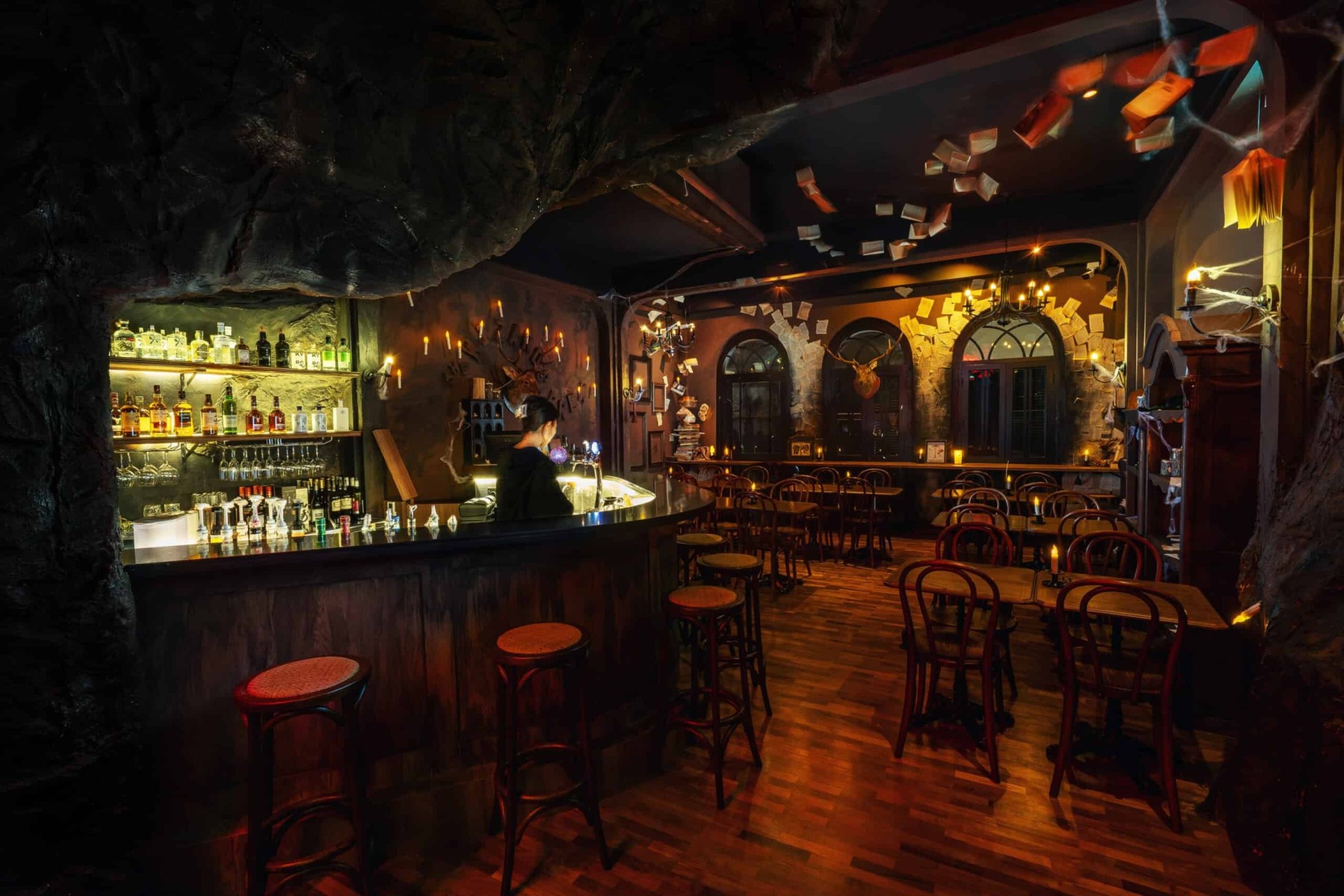 Fans of wizarding magic will definitely want to pay a visit to this bar. With a drink menu inspired by potions and spells, count yourself enchanted with every sip of your magical drink, surrounded by ornate props and awe-inspiring illusions.
Fans of wizarding magic will definitely want to pay a visit to this bar. With a drink menu inspired by potions and spells, count yourself enchanted with every sip of your magical drink, surrounded by ornate props and awe-inspiring illusions.
- Address: 10B Trengganu Street (Level 3) S058464 Singapore 058464
Nutmeg & Clove
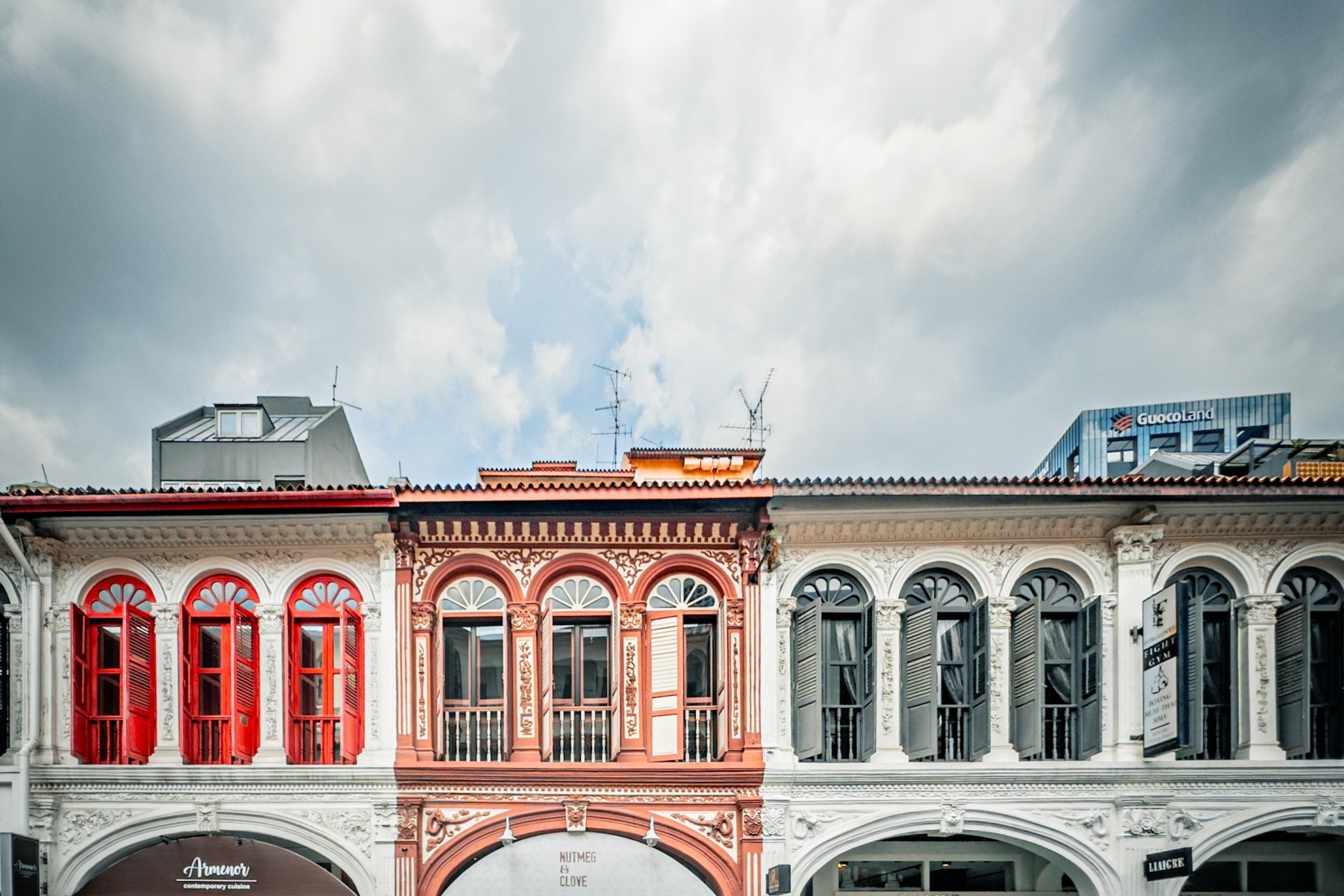 As one of Singapore’s first bars, Nutmeg & Clove remains close to our roots, offering a variety of cocktails with a charming local twist with ingredients like coriander, laksa leaves, nutmeg, and clove. With names like “Stay Calm Lah” and “Stylo Milo”, you can become acquainted with some popular local phrases over the years.
As one of Singapore’s first bars, Nutmeg & Clove remains close to our roots, offering a variety of cocktails with a charming local twist with ingredients like coriander, laksa leaves, nutmeg, and clove. With names like “Stay Calm Lah” and “Stylo Milo”, you can become acquainted with some popular local phrases over the years.
- Address: 8 Purvis Street Singapore 188587
View art
For a place steeped in culture, there’s surely art to be seen and appreciated. You have your pick of private art galleries here in this atmospheric district of Singapore, but we’ve rounded up some of the more unique galleries that will be well worth visiting.
Chinatown is also a great place to take in some street art and murals on the facades of buildings—a rarity in the organised and orderly cityscape we’re used to in Singapore.
Peranakan Tile Gallery
You may have heard of the term “Peranakan”—referring to a person who has both Chinese and Malay or Indonesian heritage— and is a unique culture in Singapore and Malaysia. Peranakan tiles are beautiful, intricate, vibrant, glazed and glossy—and rarely produced these days, if at all. Get acquainted with these gorgeous tiles at the one-of-a-kind Peranakan Tile Gallery.
- Address: 37 Pagoda Street Singapore 059196
Street Art
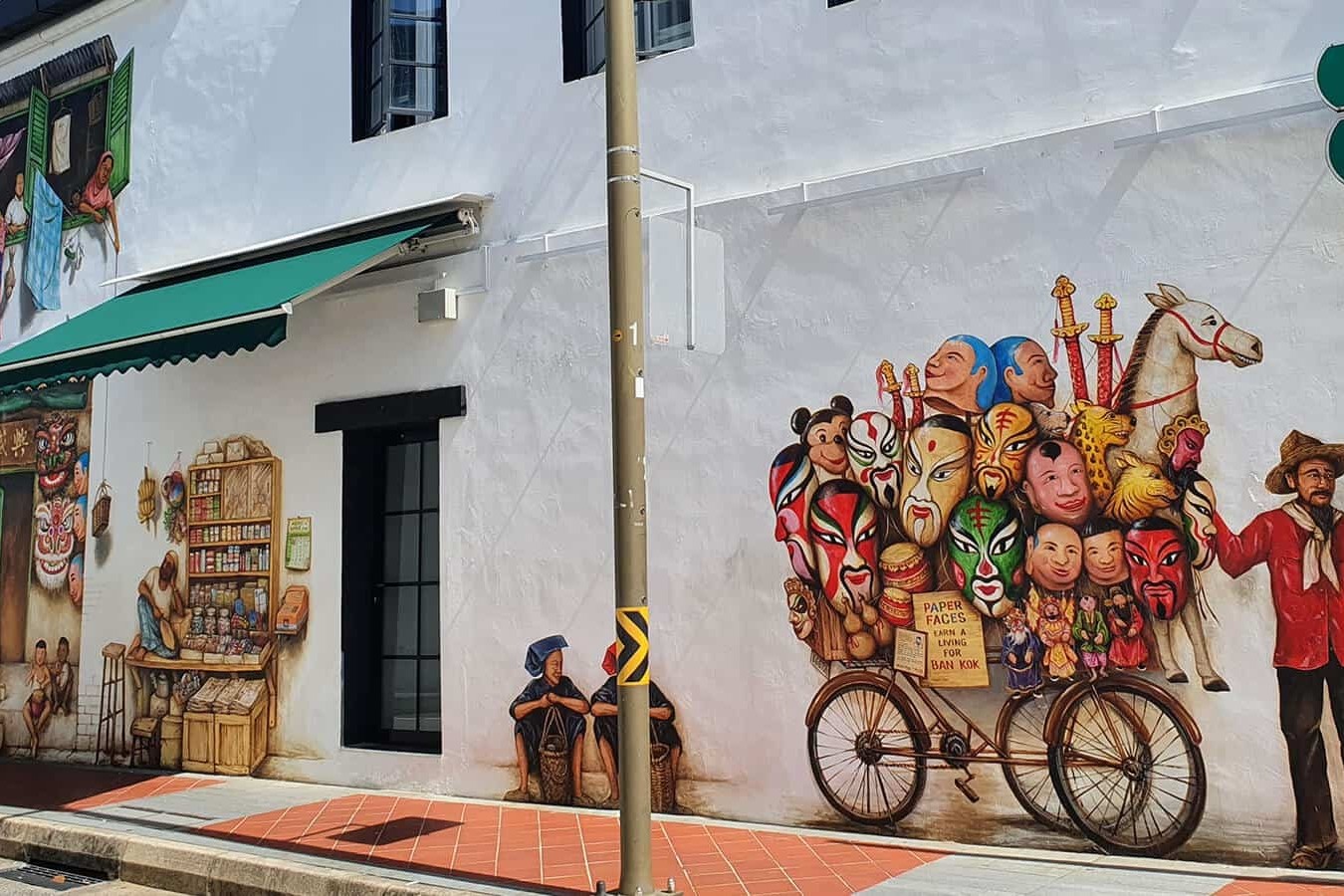 There’s plenty of street art to be enjoyed year-round in Chinatown, with some permanently painted onto building facades and statues depicting life as an immigrant lining the streets. Other art exhibitions are only there on a pop-up basis like the Chingay Parade installations. Murals can be spotted along Mohammed Ali Lane, Smith Street, Keong Saik Road, and on the walls of Amoy Street Food Centre and Chinatown Complex.
There’s plenty of street art to be enjoyed year-round in Chinatown, with some permanently painted onto building facades and statues depicting life as an immigrant lining the streets. Other art exhibitions are only there on a pop-up basis like the Chingay Parade installations. Murals can be spotted along Mohammed Ali Lane, Smith Street, Keong Saik Road, and on the walls of Amoy Street Food Centre and Chinatown Complex.
Browse the street market
Chinese New Year is the best time to visit this iconic street market in the heart of Chinatown.
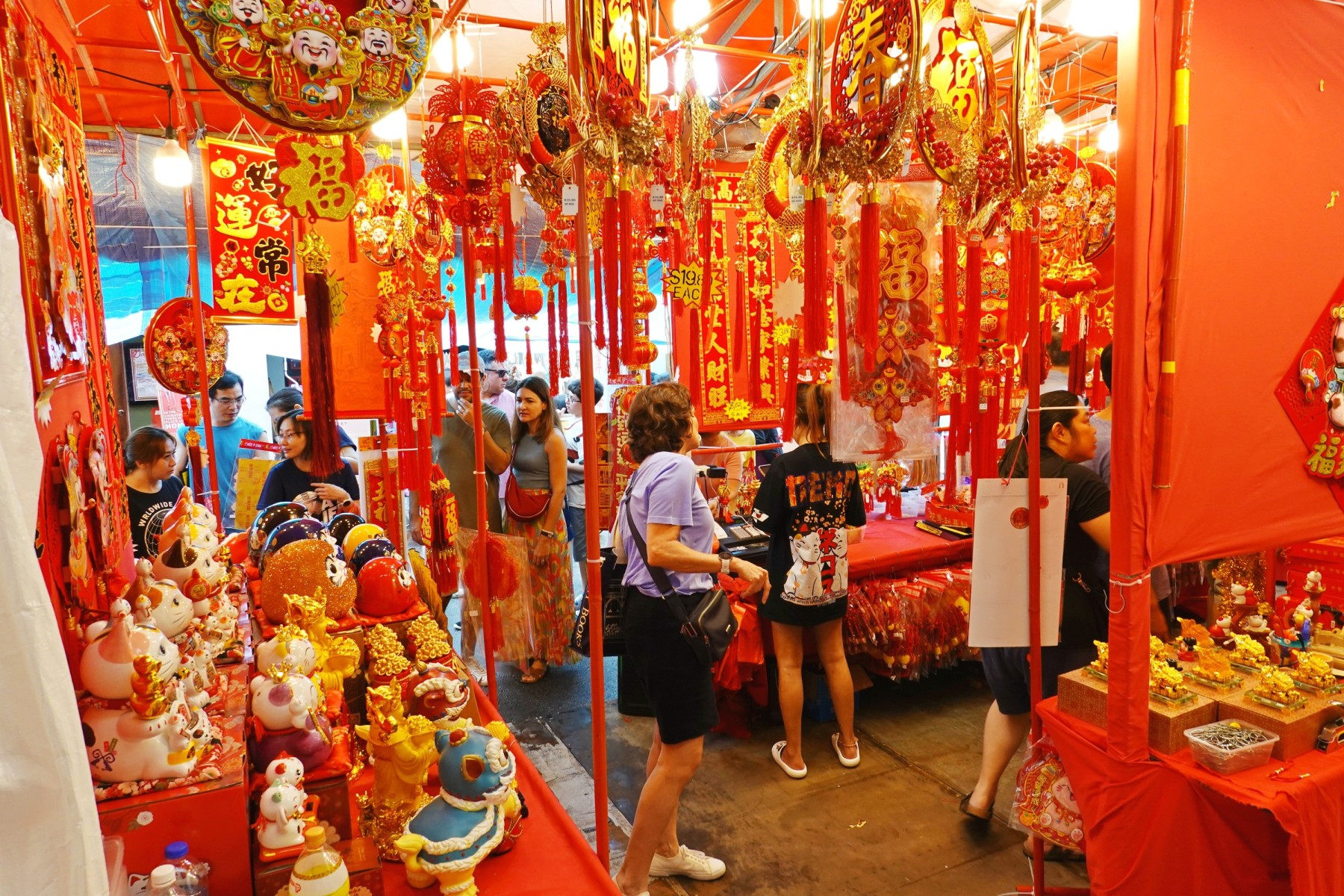 The atmosphere is positively electrifying and the vendors are all stocked up with Chinese New Year wares, decorations, and even food. Live performances and even carnival games are all part of the entertainment during this period.
The atmosphere is positively electrifying and the vendors are all stocked up with Chinese New Year wares, decorations, and even food. Live performances and even carnival games are all part of the entertainment during this period.
Another great time to browse this market is during the Mid-Autumn Festival.
During this festival, you will find vendors selling lanterns, lights, mooncakes, and other food items.
During the rest of the year, this market is still really lively and crowded, offering shoppers a wide variety of clothes, Chinese ornaments like chopstick holders, painted paper fans, and personalised calligraphy or paintings.
Grab some food from the row of eateries lining the streets and enjoy the stroll!
Pro-tip: You can always try asking the vendors for the best price that they can offer. Sometimes, they will be willing to lower the price a little, especially if you want to buy more than one item from their stall.
Visit Temples
In multireligious and multicultural Singapore, people of all religions and ethnicities are welcome to visit the temples and learn more about the religions. These temples in Chinatown are cultural wonders in their own right, some of which have been there for centuries since the first immigrants arrived.
Almost all of these temples are free to enter. Visitors must, however, adhere to a dress code that covers the backs, shoulders, and thighs to show respect. As a visitor, you should also not bring food or pets into the temples.
Buddha Tooth Relic Temple
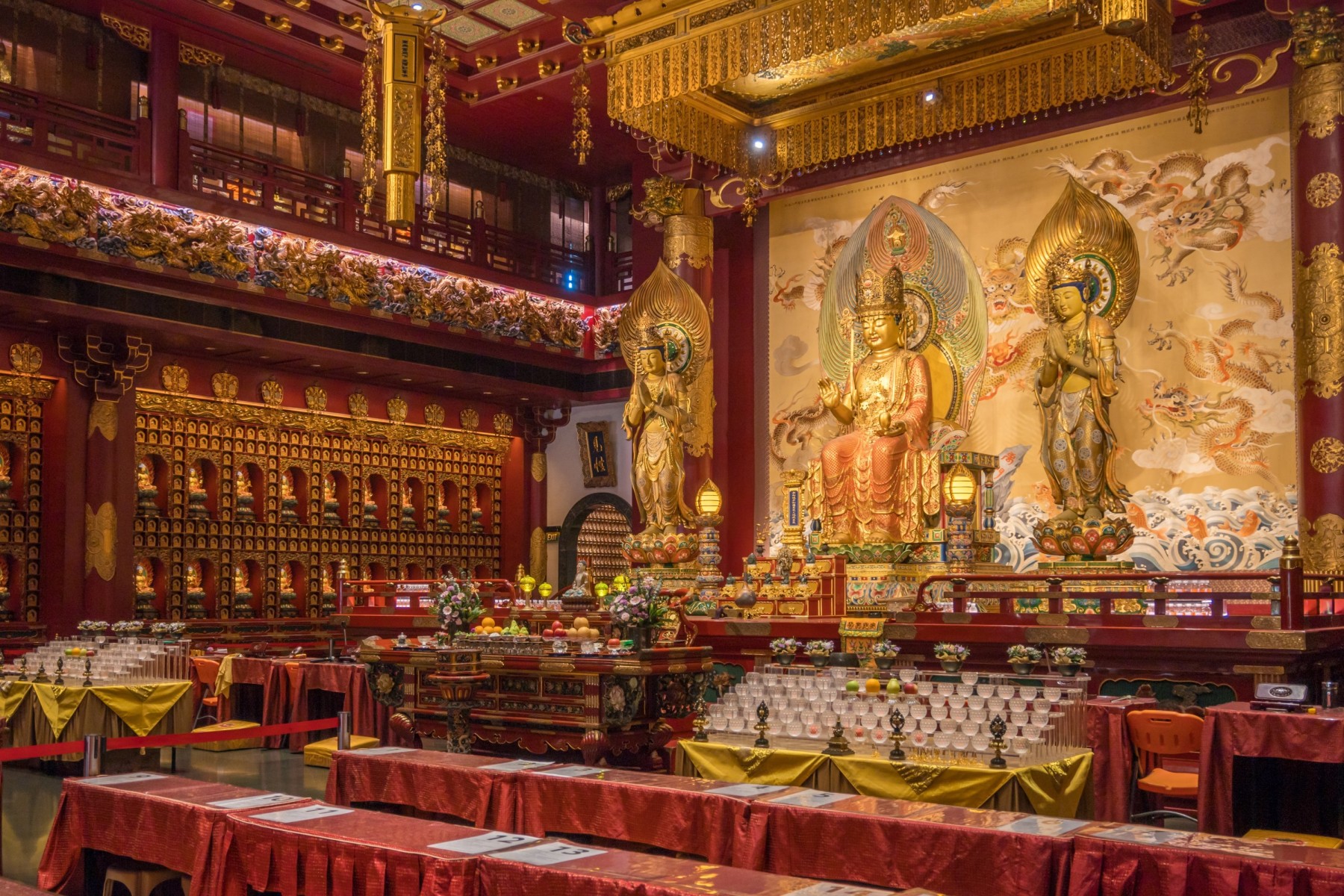 This Tang-style Buddhist temple built in 2007 houses the sacred Buddha tooth relic in a 320kg gold stupa, and is a revered place of worship for Buddhists. With its richly decorated interior and peaceful atmosphere, the Buddha Tooth Relic Temple is a great place of contemplation for devotees and non-devotees alike.
This Tang-style Buddhist temple built in 2007 houses the sacred Buddha tooth relic in a 320kg gold stupa, and is a revered place of worship for Buddhists. With its richly decorated interior and peaceful atmosphere, the Buddha Tooth Relic Temple is a great place of contemplation for devotees and non-devotees alike.
- Address: 288 South Bridge Road, Singapore 058840
- Dress code: No bare backs, off-shoulders, shorts or mini-skirts.
Thian Hock Keng Temple
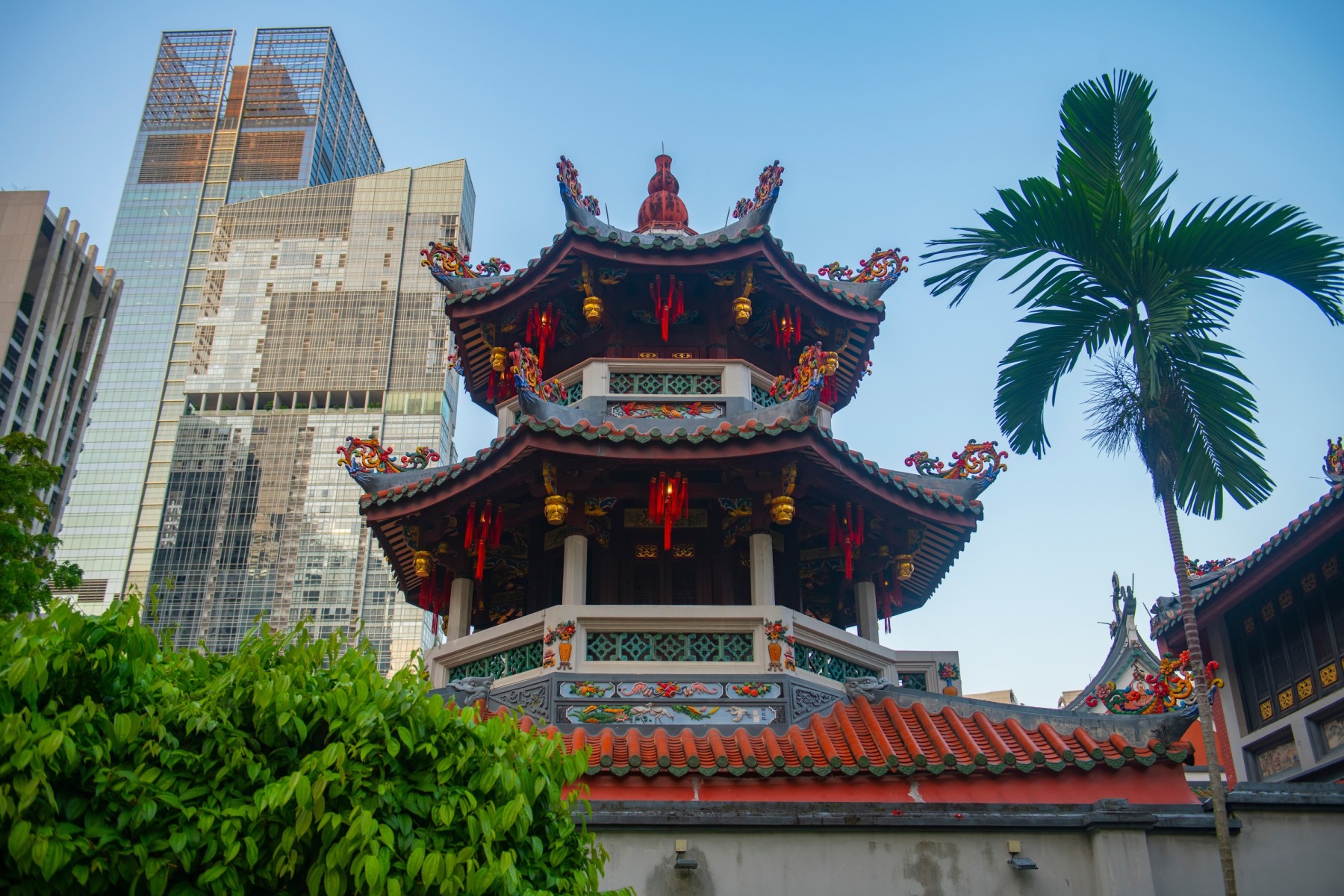 The Thian Hock Keng Temple, which means “Temple of Heavenly Happiness” in Hokkien, was built in the 1800s and specially dedicated to the Chinese sea goddess, Mazu. Immigrants would always stop by the temple to pray for a smooth journey home on the seas or thank her for bringing them safely to shore. As a testament to the multi-religious nature of Singapore, the temple’s devotees include those from the Taoism, Buddhism, and Confucianism faiths, as well as those who practice ancestral worship.
The Thian Hock Keng Temple, which means “Temple of Heavenly Happiness” in Hokkien, was built in the 1800s and specially dedicated to the Chinese sea goddess, Mazu. Immigrants would always stop by the temple to pray for a smooth journey home on the seas or thank her for bringing them safely to shore. As a testament to the multi-religious nature of Singapore, the temple’s devotees include those from the Taoism, Buddhism, and Confucianism faiths, as well as those who practice ancestral worship.
- Address: 158 Telok Ayer Street, Singapore 068613
- Dress code: No bare backs, off-shoulders, shorts or mini-skirts.
Yu Huang Gong
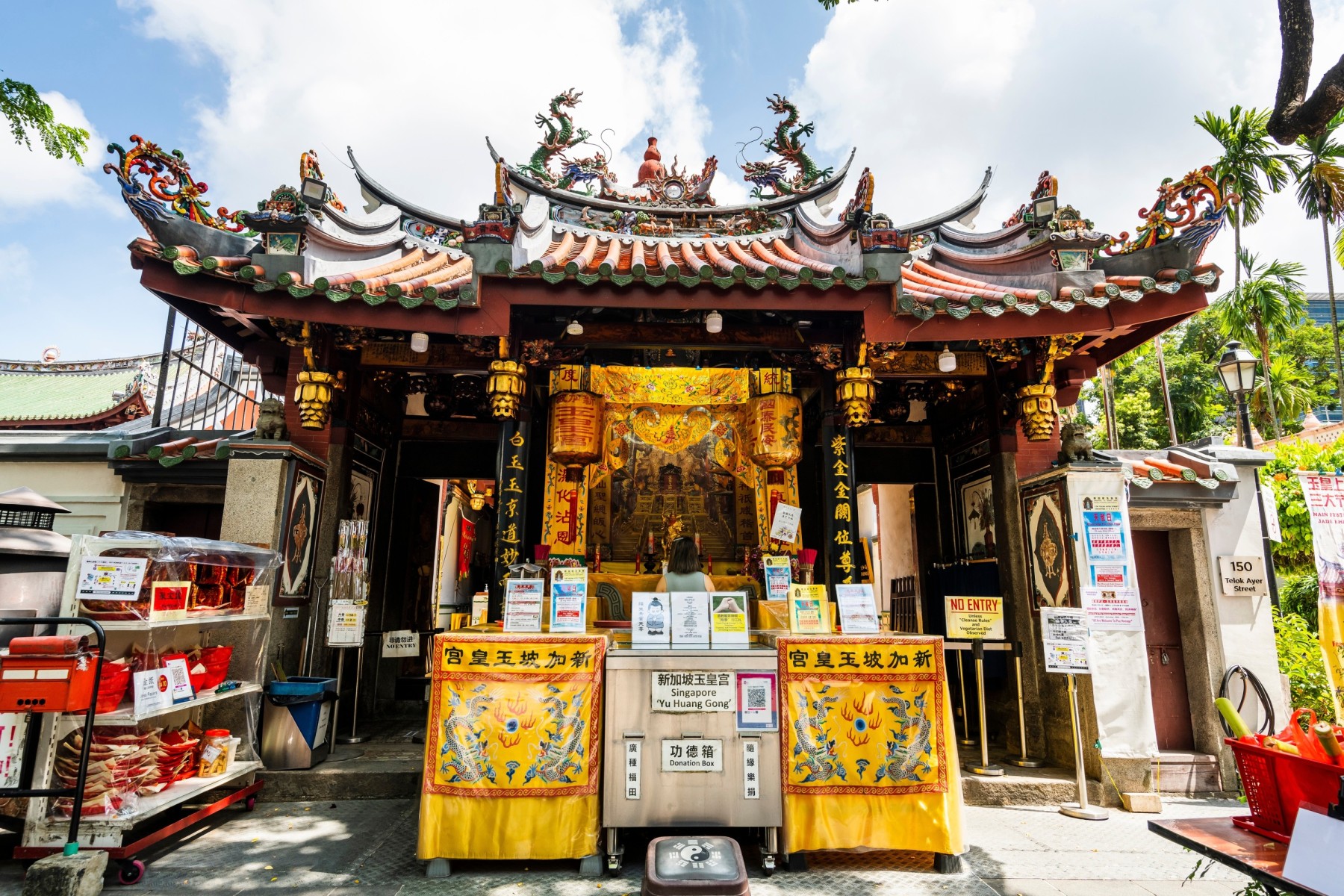 Temple of the Heavenly Jade Emperor: Located beside Thian Hock Keng Temple, the Temple of the Heavenly Jade Emperor is equally worth visiting in its own right with its eye-catching octagonal pagoda. This Taoist temple is dedicated to the Jade Emperor, the highest divinity in Taoism. It was a private temple until it was bought over by the Taoist Mission in 2010, and opened its doors to the public in January 2015.
Temple of the Heavenly Jade Emperor: Located beside Thian Hock Keng Temple, the Temple of the Heavenly Jade Emperor is equally worth visiting in its own right with its eye-catching octagonal pagoda. This Taoist temple is dedicated to the Jade Emperor, the highest divinity in Taoism. It was a private temple until it was bought over by the Taoist Mission in 2010, and opened its doors to the public in January 2015.
- Address: 150 Telok Ayer Street, Singapore 068608
- Dress code: No bare backs, off-shoulders, shorts or mini-skirts.
Sri Layan Sithi Vinayagar Temple
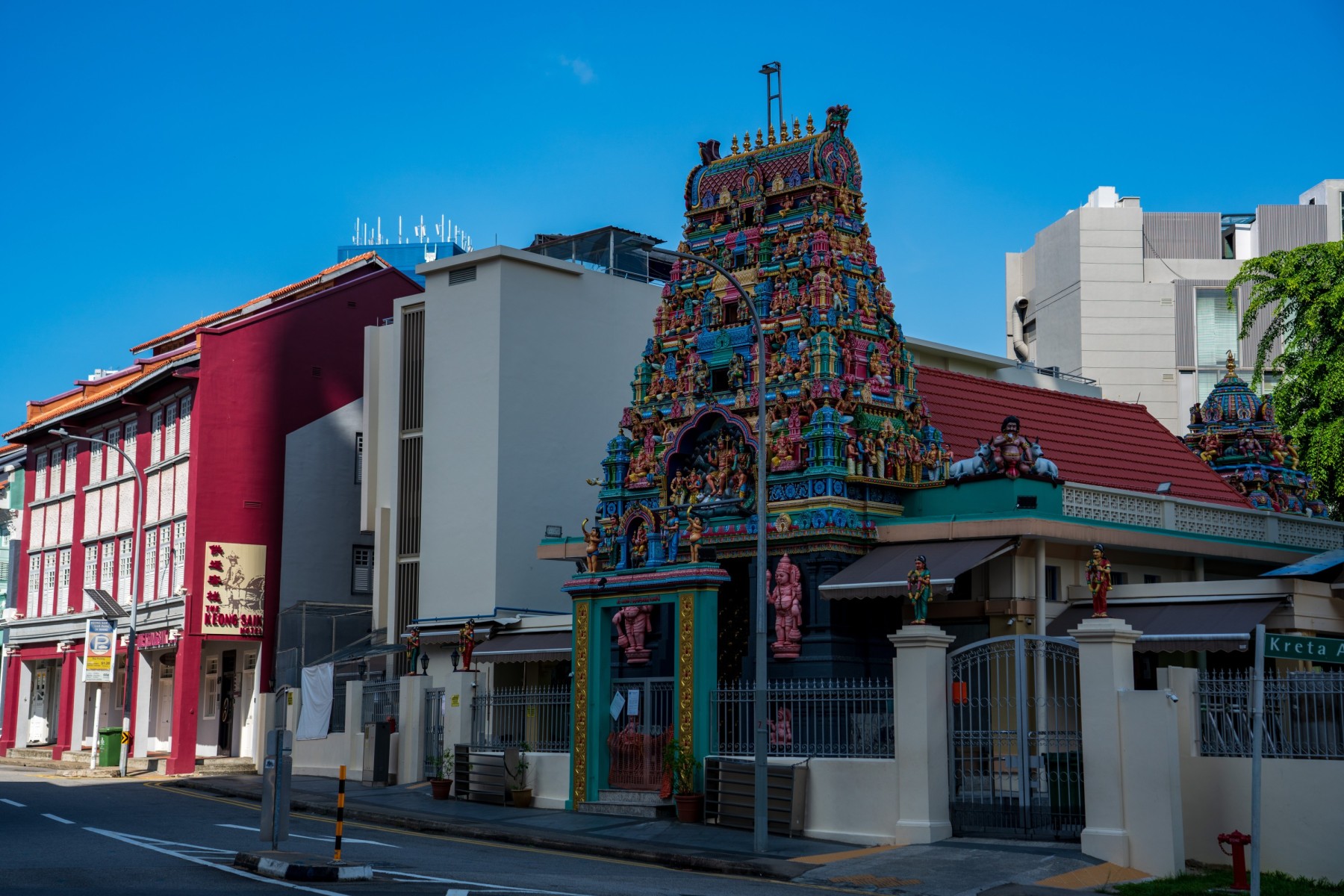 Originally a humble tap-roofed temple in 1917, the temple was transformed into what it is today in 2007 by the Nagarathar family, who are the current administrators of the temple. Walk through its ornate and colourful entrance tower and you’ll be greeted by a sense of calm and peace, as the monks and devotees pray to the deities.
Originally a humble tap-roofed temple in 1917, the temple was transformed into what it is today in 2007 by the Nagarathar family, who are the current administrators of the temple. Walk through its ornate and colourful entrance tower and you’ll be greeted by a sense of calm and peace, as the monks and devotees pray to the deities.
- Address: 73, Keong Saik Road, Singapore 089167
- Dress code: No bare backs, off-shoulders, shorts or mini-skirts, cover-ups will be provided. Shoes must be removed.
Sri Mariamman Temple
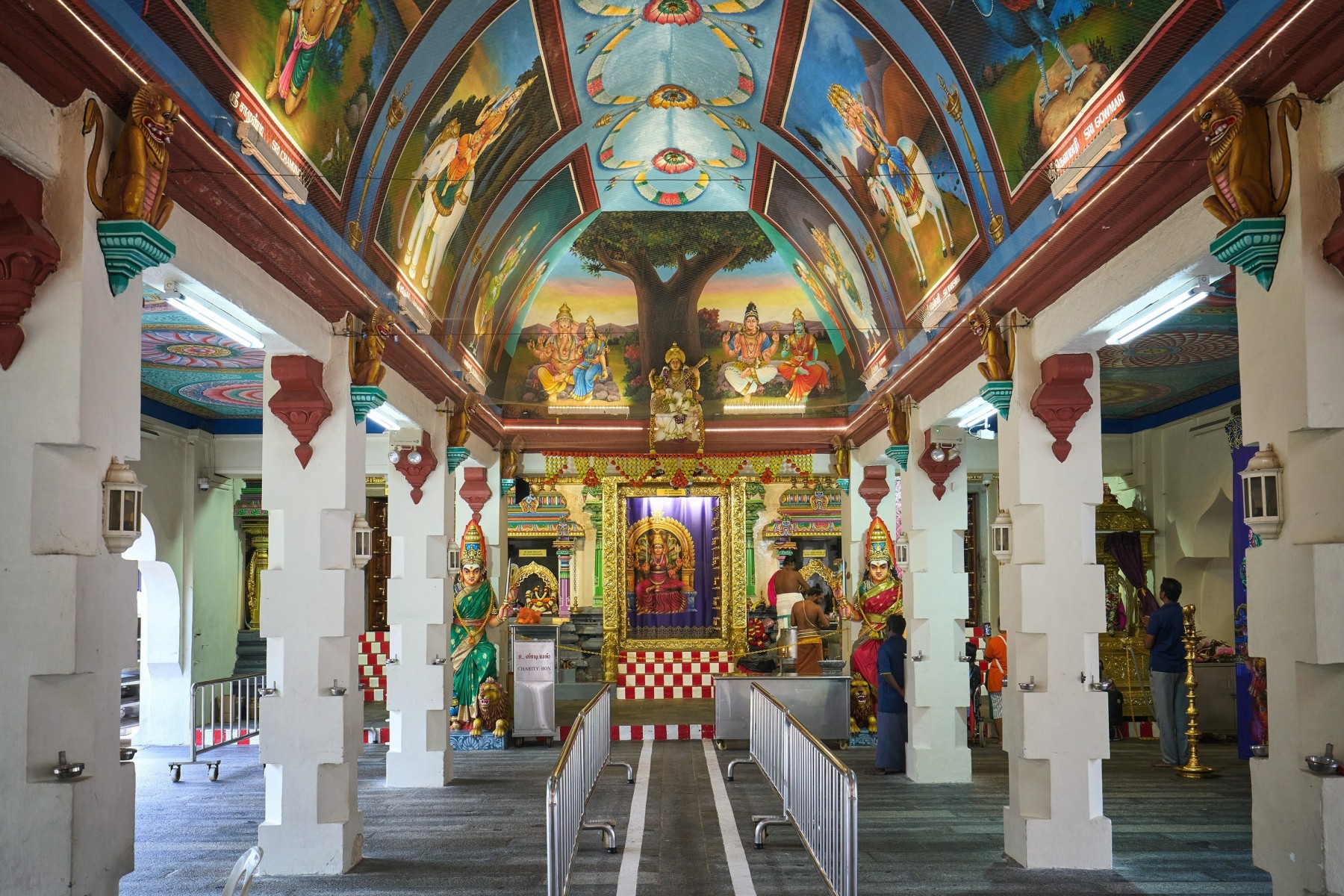 As Singapore’s oldest Hindu temple, the Sri Mariamman Temple is an architectural marvel, with its elaborate six-tiered entrance tower featuring plaster sculptures of deities hand-painted. Today, it is still a significant meeting point and community for newly arrived immigrants, particularly the South Indian Tamil Hindus.
As Singapore’s oldest Hindu temple, the Sri Mariamman Temple is an architectural marvel, with its elaborate six-tiered entrance tower featuring plaster sculptures of deities hand-painted. Today, it is still a significant meeting point and community for newly arrived immigrants, particularly the South Indian Tamil Hindus.
- Address: 244 South Bridge Rd, Singapore 058793
- Dress code: No bare backs, off-shoulders, shorts or mini-skirts. Cover-ups will be provided. Shoes must be removed.
Appreciate some tea
Chinese tea appreciation is a whole thing on its own. It’s an important aspect of Chinese culture all over the world.
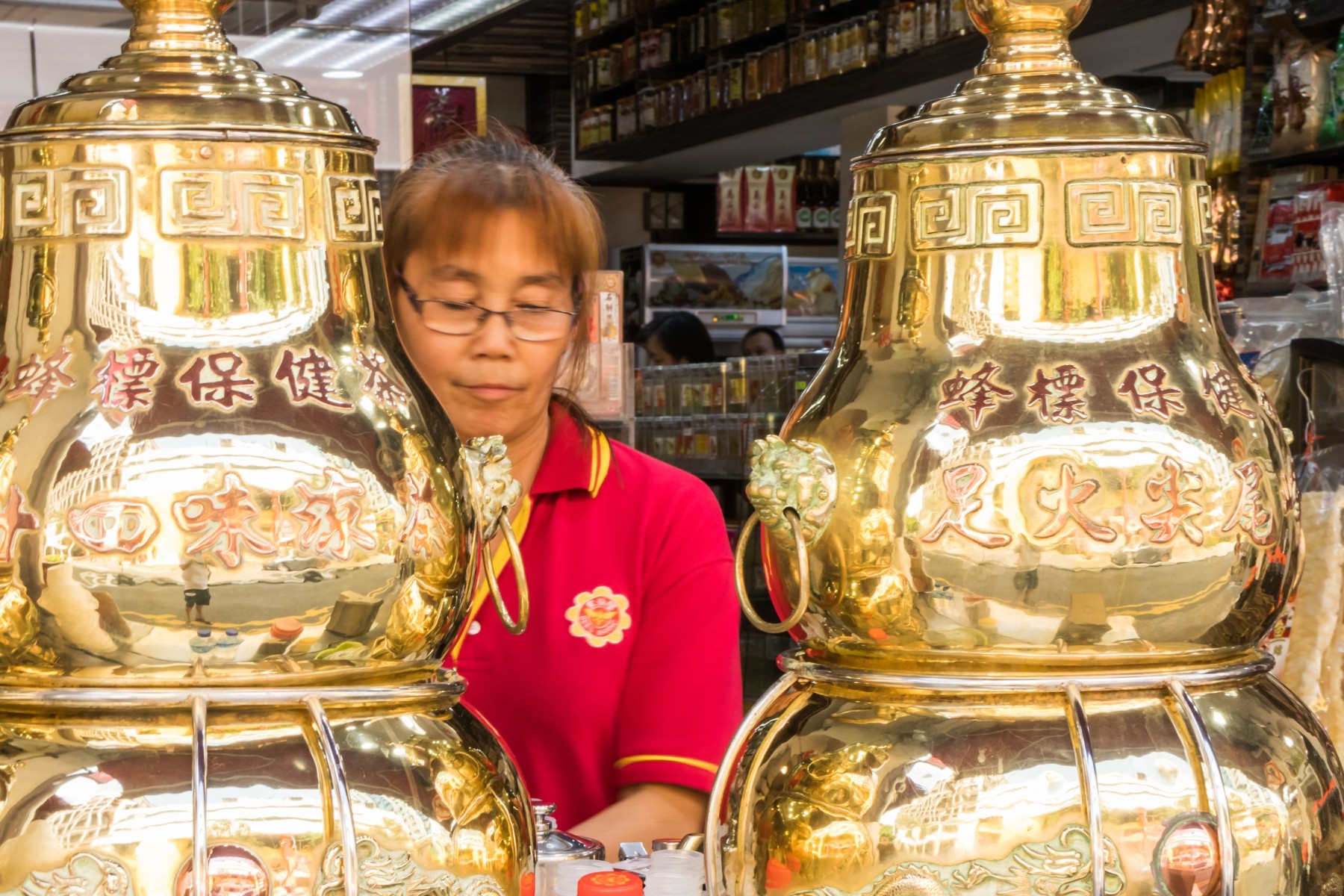 The art of brewing, pouring, serving, and drinking a cup of tea is rich in symbolism. And where better to be acquainted with this than in Chinatown? These tea houses offer tea appreciation workshops to show you exactly how you should drink a cup of Chinese tea for its fullest enjoyment.
The art of brewing, pouring, serving, and drinking a cup of tea is rich in symbolism. And where better to be acquainted with this than in Chinatown? These tea houses offer tea appreciation workshops to show you exactly how you should drink a cup of Chinese tea for its fullest enjoyment.
Tea Chapter
Singapore’s largest and oldest teahouses have been advocating for the preservation of Chinese tea culture all these years. Drop by their shop along Neil Road and participate in one of their immersive and educational tea workshops to pick up the finer points of tea culture.
- Address: 9 Neil Rd, Singapore 088808
Yixing Xuan Teahouse
Dive deep into Chinese culture and learn to recognise the different tea leaves at these open-to-public workshops held at Yixing Xuan Teahouse. You’ll sample different types of Chinese tea and learn to tell the subtle difference in taste, as well as enjoy delicious dim sum with the tea. Win-win!
- Address: 78 Tanjong Pagar Road Singapore 088499
Silk Tea Bar
Tea appreciation with a modern, minimalist aesthetic can be experienced at Silk Tea Bar, which truly looks more like a trendy wabi-sabi-styled cafe than a tea house. Take a leisurely hour to savour the contemporary tea bar’s single-origin teas, which are brewed in Australian spring water for minimal inference from minerals and served in Instagram-worthy wares.
- Address: 26A Sago Street, Singapore 059021
Pek Sin Choon Tea Merchants
Tucked away along an unassuming row of shophouses at Mosque Street, is one of Singapore’s oldest tea merchants— Pek Sin Choon. It supplies tea leaves daily to the vast majority of bak kut teh shops in Singapore, as well as the popular restaurant Din Tai Fung. Stop by this Pek Sin Choon to buy some tea leaves to brew yourself a pot of tea at home, and try them at the traditional brewing station at the stall.
- Address: 36 Mosque St Singapore 059514
Visit museums
Chinatown Heritage Centre
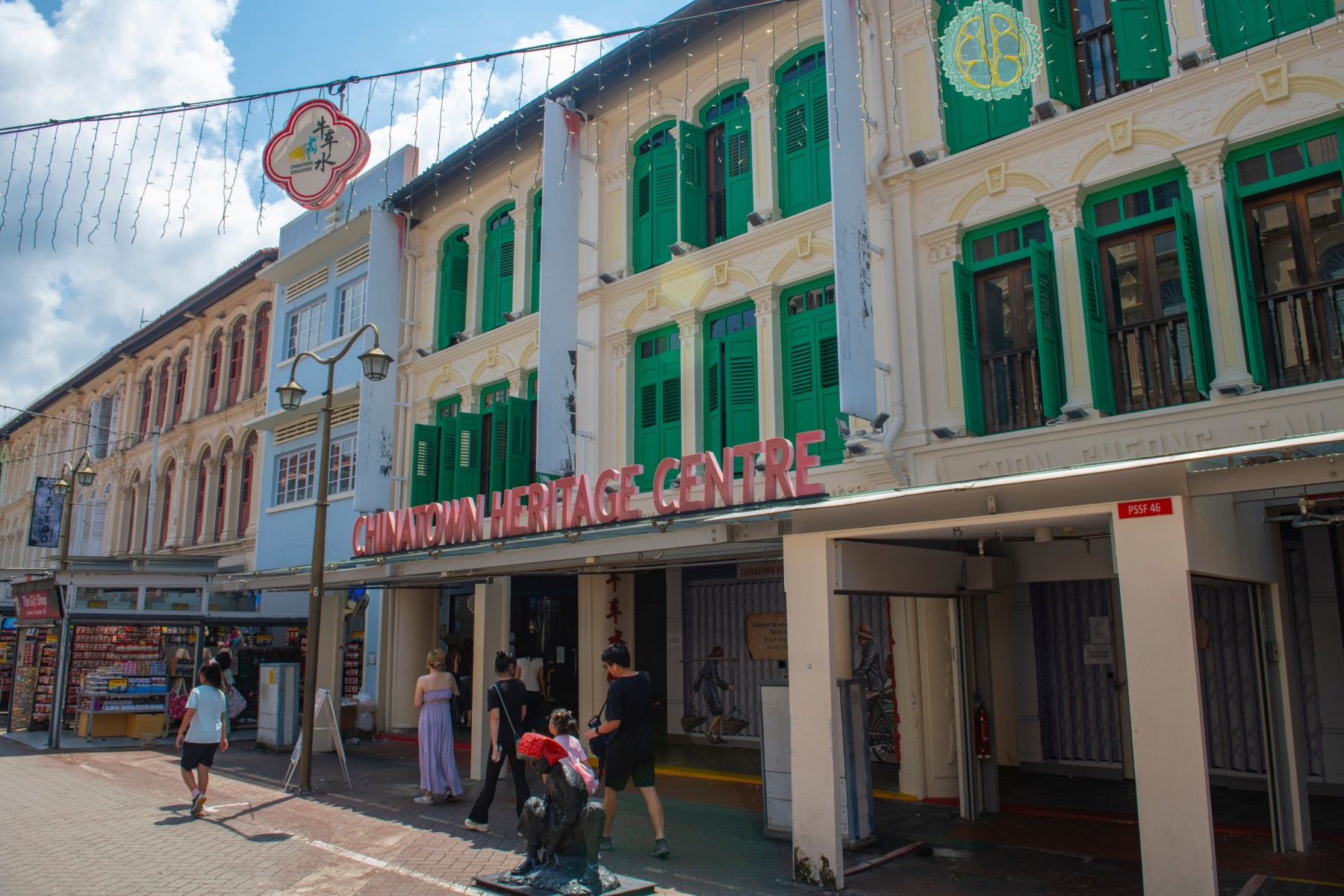 Step into the recently re-opened Chinatown Heritage Centre—it’s like stepping through a time portal into Chinatown from centuries ago. You’ll get to experience what it was like for the early Chinese immigrants to live in shophouses, what their lives were like in Chinatown, and learn about what led them to come to Singapore. An entry fee to this museum is payable and tickets must be booked before visiting.
Step into the recently re-opened Chinatown Heritage Centre—it’s like stepping through a time portal into Chinatown from centuries ago. You’ll get to experience what it was like for the early Chinese immigrants to live in shophouses, what their lives were like in Chinatown, and learn about what led them to come to Singapore. An entry fee to this museum is payable and tickets must be booked before visiting.
- Address: 48 Pagoda Street, Singapore 059207
Kreta Ayer Heritage Gallery
This dedicated gallery showcases Kreta Ayer’s rich cultural heritage, including traditional art forms such as Chinese opera, Chinese puppetry, and Nanyin music—a form of music from the Tang dynasty that is performed using vocals and a specific set of wind, string and percussion instruments—tea appreciation and calligraphy. Get to know Kreta Ayer’s history and legacy through photographs, stories and objects from the community. Entry is free.
- Address: 28 Kreta Ayer Road Singapore 088995
Fuk Tak Chi Museum
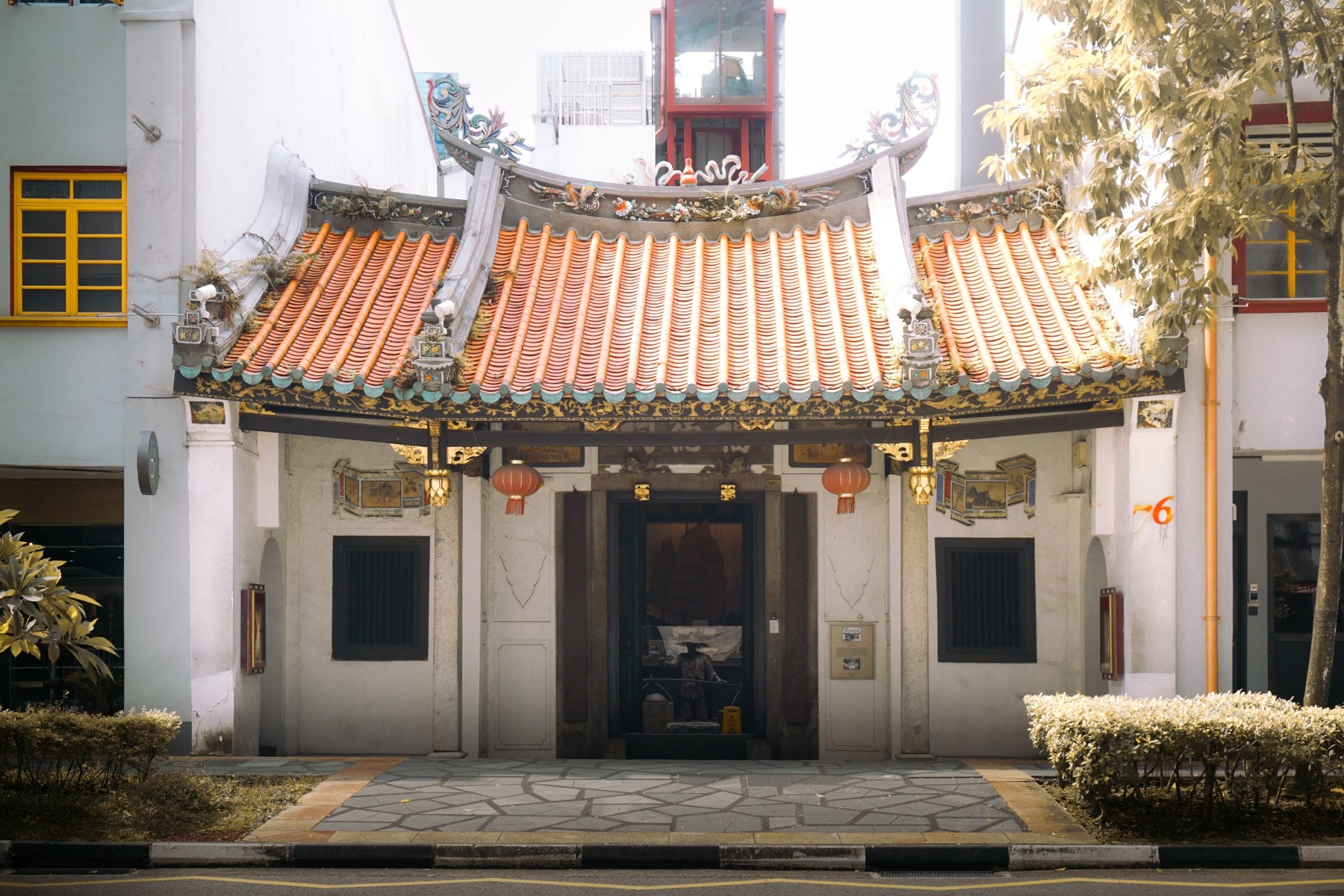 If you’re in the vicinity of Amoy Hotel, pop into the lobby to explore this quiet street museum, which details the lives of the early Chinese immigrants to Singapore through intricate and life-like miniature displays, As part of an old temple dedicated to the Chinese deity Tua Pek Kong, and then later becoming the headquarters for the Cantonese and Hakka communities, it has been preserved to accurately show the walls, courtyard and well of the original building. Entry is free.
If you’re in the vicinity of Amoy Hotel, pop into the lobby to explore this quiet street museum, which details the lives of the early Chinese immigrants to Singapore through intricate and life-like miniature displays, As part of an old temple dedicated to the Chinese deity Tua Pek Kong, and then later becoming the headquarters for the Cantonese and Hakka communities, it has been preserved to accurately show the walls, courtyard and well of the original building. Entry is free.
- Address: 76 Telok Ayer Street, Singapore 048464
Buddha Tooth Relic Museum
Comprises of three distinct museums within the sprawling temple complex—visitors will be taken on an awe-inspiring journey to learn about Buddhism. The three museums are: the Buddhas of the World Museum for visitors to experience the life story of Buddha Shakyamuni; the Sacred Relics Museum displaying important relics of the Buddha and his disciples; and the Eminent Sangha Museum which shows the spread of Buddhism across Asia and features the life-stories of eminent monks from all around the world.
- Address: 288 South Bridge Road, Singapore 058840
Travelling to Chinatown
Located practically in the heart of the city, Chinatown is a breeze to get to, and equally delightful to travel within.
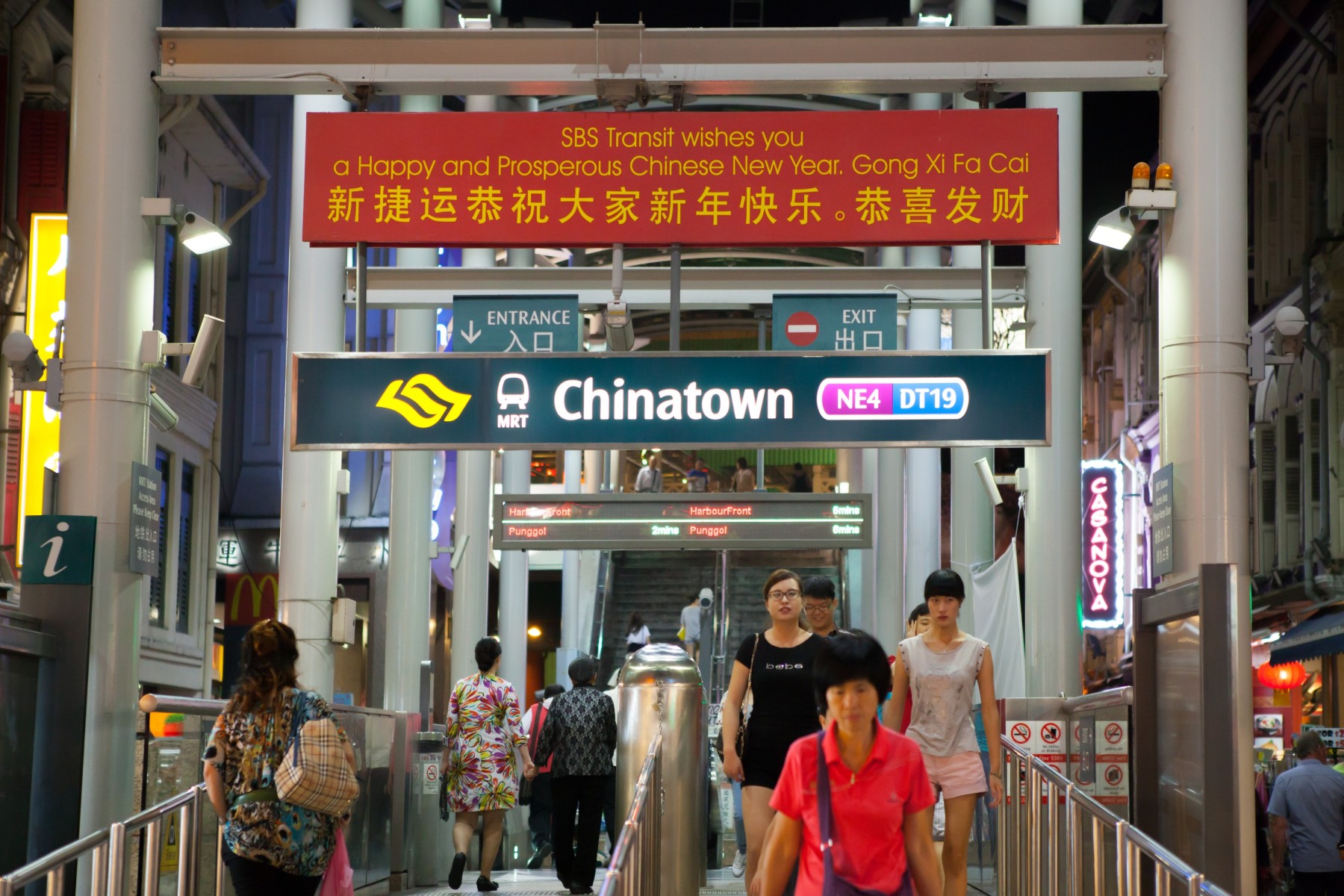 There are five Mass Rapid Transit (MRT) stations serving the district via the Nouth-South Line (NEL), East-West Line (EWL), Downtown Line (DTL), and Thomson-East Coast Line (TEL), along the following stops—there’s surely a train line near you that will take you to Chinatown:
There are five Mass Rapid Transit (MRT) stations serving the district via the Nouth-South Line (NEL), East-West Line (EWL), Downtown Line (DTL), and Thomson-East Coast Line (TEL), along the following stops—there’s surely a train line near you that will take you to Chinatown:
- Chinatown Station (NE4 / DT19)
- Maxwell Station (TE18)
- Telok Ayer Station (DT18)
- Tanjong Pagar Station (EW15)
- Outram Park Station (EW16 / TE17)
Bus services are also plentiful within the district, with bus numbers 12, 147, 174, 197, 2, 33, 54, 61, and 851E serving the various areas of Chinatown.
If you’re feeling like you can brave the heat and humidity, exploring Chinatown on foot is also a great option, walking from street to street to soak in all the vibes and take in the rich sights and sounds up close.
Where to live in Singapore’s Chinatown?
If you’re smitten by Chinatown’s unique blend of modernity and tradition and want to live right in the midst of it all, explore the government-built residential HDB blocks at Smith Street, Upper Cross Street, Cantonment Road, Kreta Ayer Road, Sago Lane, Duxton, or Temple Street.
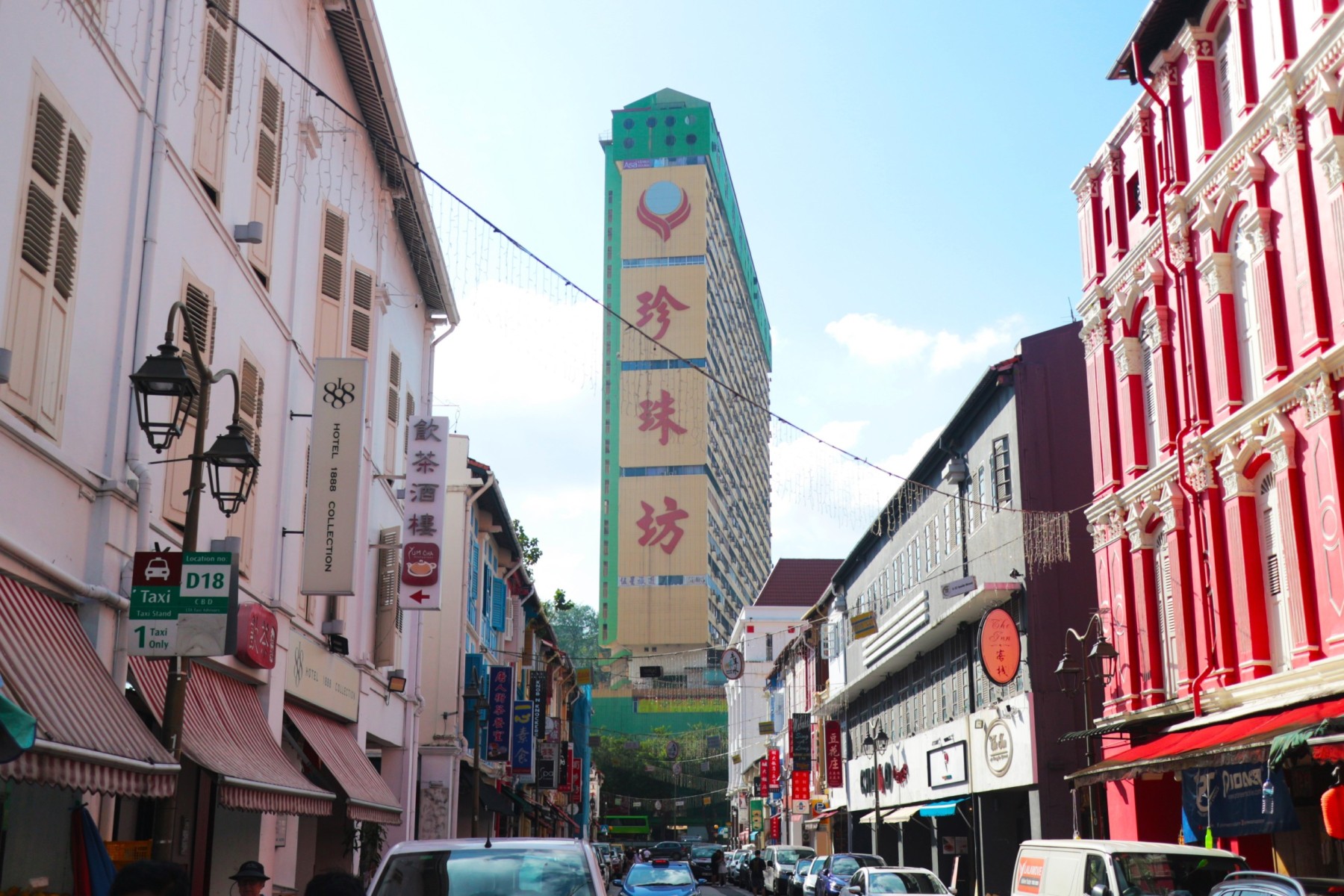
If living in a shophouse like the early Immigrants appeals to you, there are units for rent at Club Street, Neil Road, Mosque Street, and Tras Street.
Condominium developments in Chinatown are concentrated in Tanjong Pagar and Spottiswoode Park.
What do our customers say?






